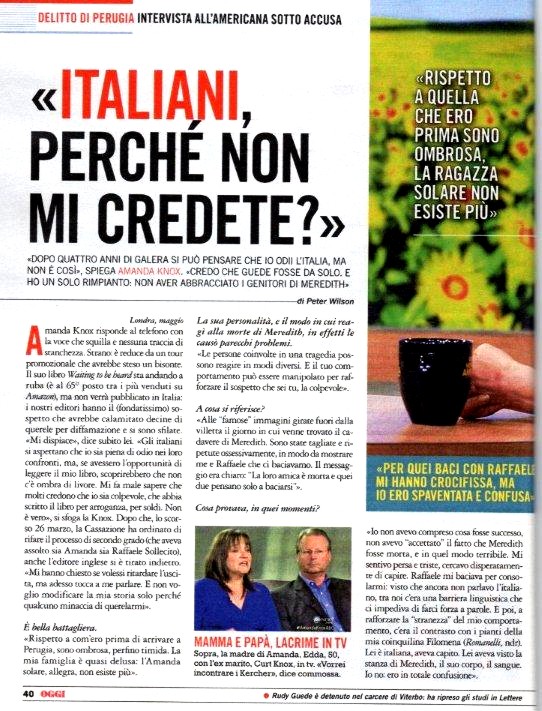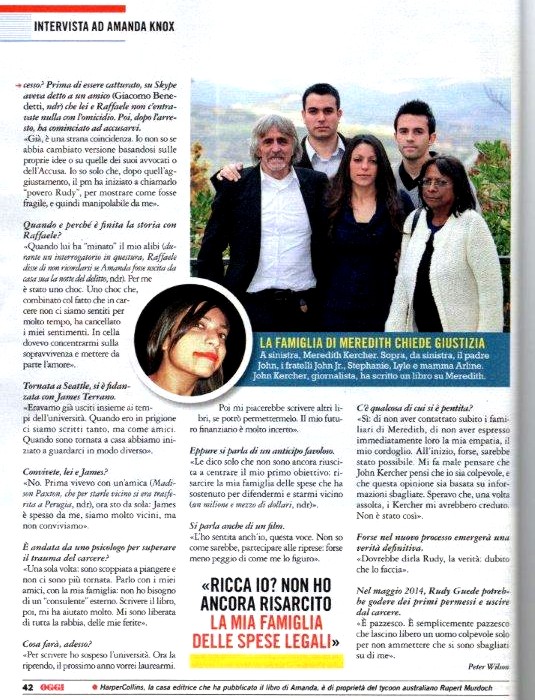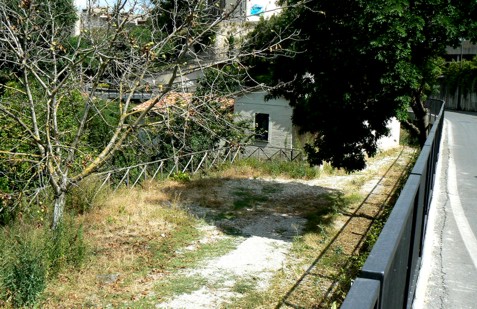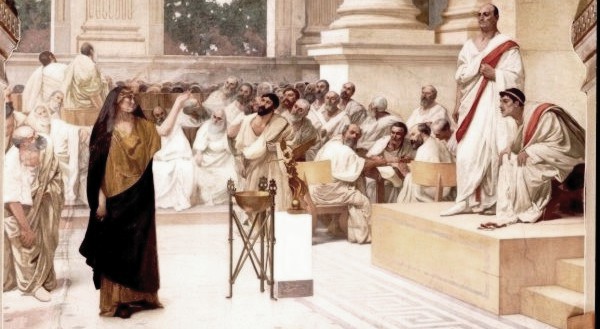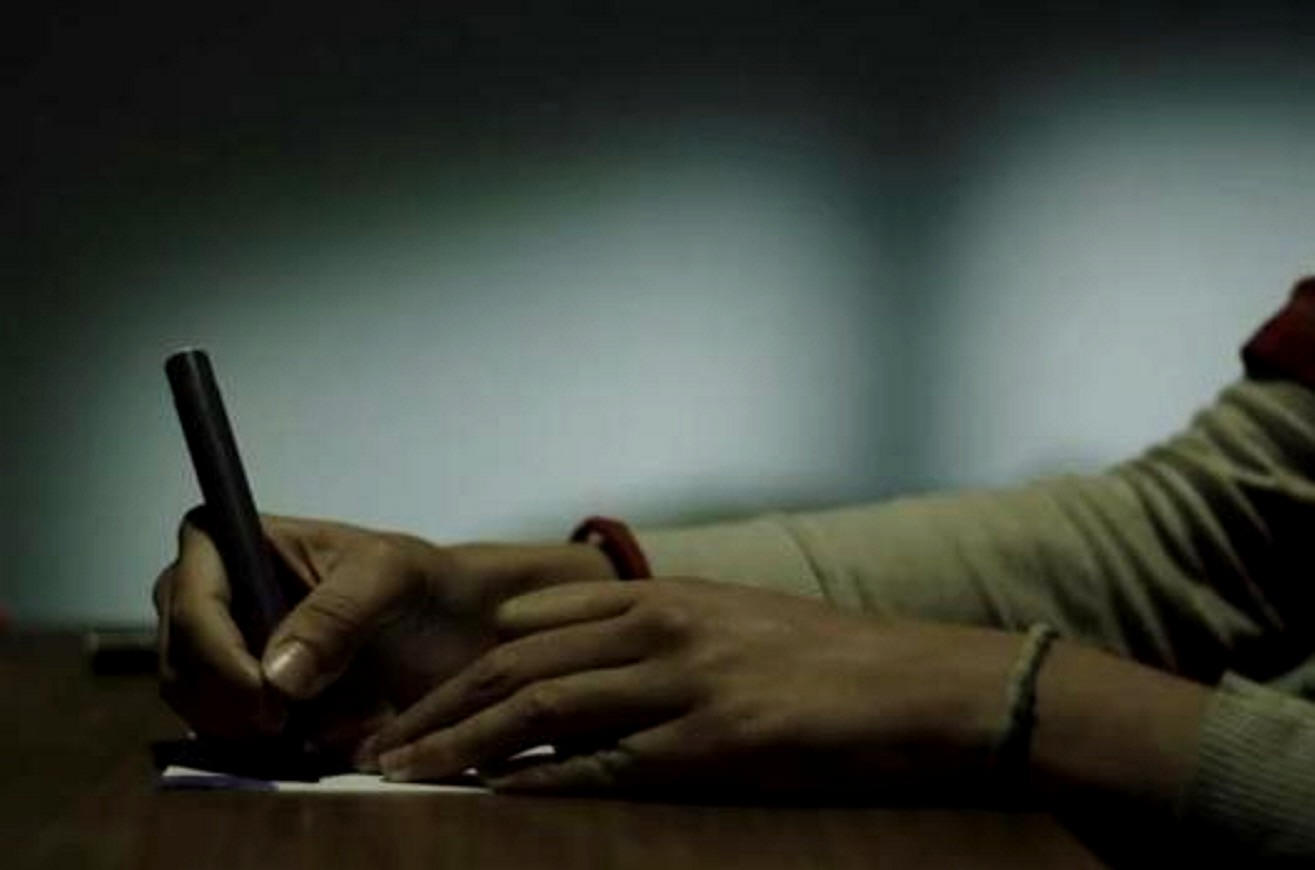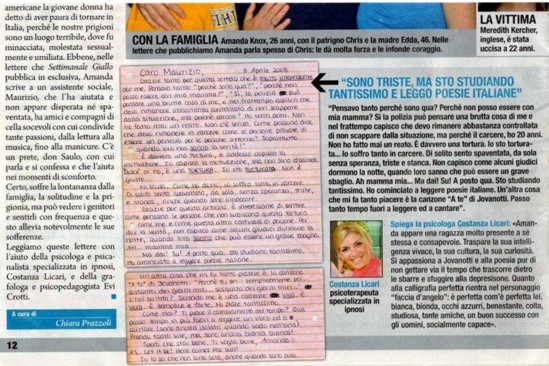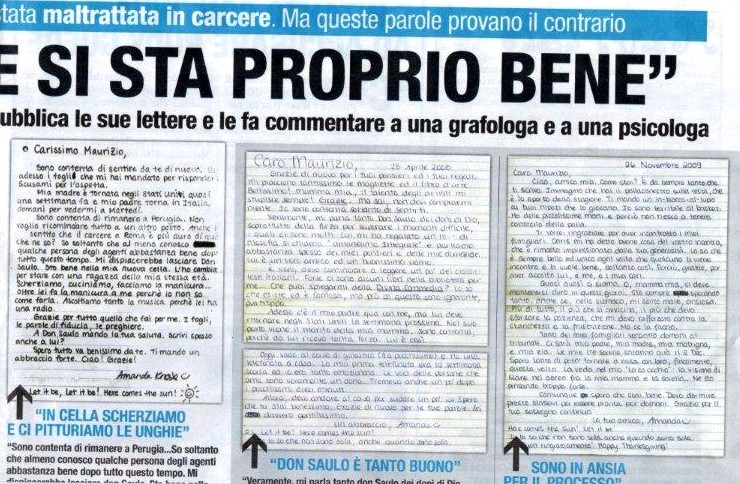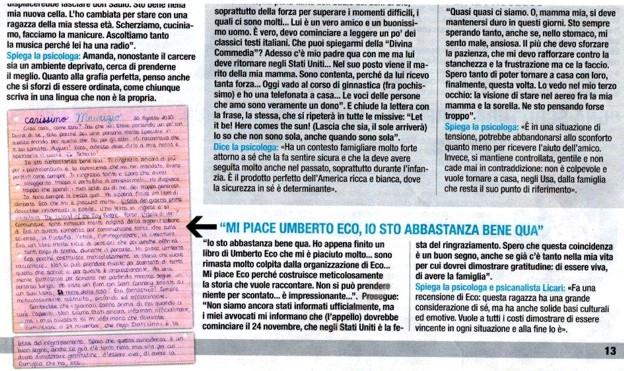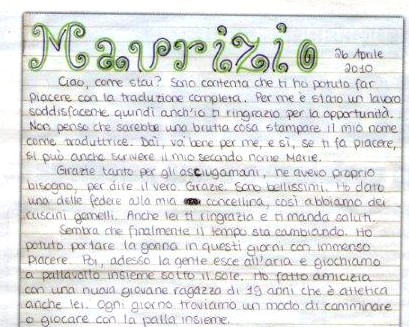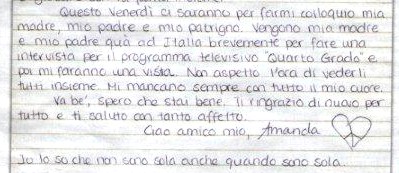
Category: Amanda Knox
Thursday, September 05, 2013
Questions For Knox: Why So Many False Claims In Accounts Of Your Visit To The House?
Posted by James Raper
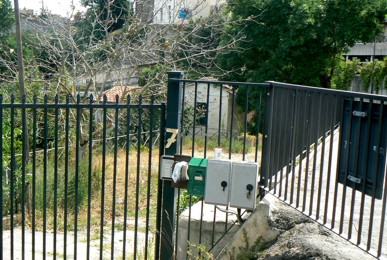
[Filomena’s shutters on approach above and below NOT half-open as they were when Knox arrived]
Additional to this post and this post on the overwhelming strength of the evidence against Sollecito and Knox.
Amanda Knox was of course lying from the start about her initial visit to the cottage to have a shower and collect a change of clothing, in the account which she gave the police when they turned up, and which she then embellished into a version of Little Red Riding Hood in her e-mail.
Here’s how we can know why. One of her most glaringly untrue claims, one not hard to fathom out and indeed I have no doubt that she had done so herself and regretted it within minutes of recounting her story to the police.
The shutters to Filomena’s window were open upon the arrival of the postal police. Massei (page 27) -
Said window had two half-closed shutters, and the right-hand shutter (the right with respect to the person looking at it) was slightly more open”› (page 62, hearing of February 6, 2009, Battistelli’s statements).
Filomena’s window is in fact the most prominent feature of the cottage for anyone walking down the lane to it. Yet, incredibly, if we are to make sense of the rest of her account, we are required to believe that Knox did not notice the shutters .
Whether they were half open or less than half open does not matter. They were open, indicating, as a matter of common sense, that the occupant of the room might be somewhere around.
You would think that anyone (anyone but Knox apparently) apprised of this elementary scrap of information about their own home and flatmates, and then in addition finding that the front door was open and no-one was answering, would have checked the other rooms, and in particular Filomena’s, out of curiosity if not concern, wouldn’t you? Of course you would.
Discovery of the broken window would then, if not before, have been inevitable, but of course in those circumstances no one would have believed that she had then had a shower and blow dried her hair.
Of course it did occur to the police that her story was a load of nonsense, just as it did to Knox and Sollecito.
See at bottom here for the famous picture of Knox and Sollecito together outside the cottage, Knox with her left hand up to her eyes and Sollecito by her side standing with his back to the window, jaws clenched and staring blankly straight ahead.
They knew, and they must have been praying hard that the police were just as stupid as them. When they were not arrested on the spot they must have thought their prayers were answered.

[Shower? Knox with Sollecito several hours later at which point her body odour was reported as immense]
Thursday, August 29, 2013
Amanda Knox Dithering Over Court Appearance For Appeal Going Over Very Negatively In Italy
Posted by Peter Quennell

[Above: the outspoken political leader of the region of Umbria Lignani Marchesani warns Amanda Knox]
Amanda Knox has her name on a book that maliciously slimes everybody she ever encountered in Italy. Then she repeatedly goes on TV whining about how people dont like or trust her.
Guess what? Italians are seeing those same wild accusations as being one self-created reason why Knox seems to lack the guts to head for the appeal court. She would be put face-to-face with many of those that she slimed. How embarrasing.
The other reason of course has applied since 2009: Italians believe she really did lead a very cruel murder pack, killed someone vastly more gifted and worthwhile than herself, and now is lying to the American public in the hope that they will insist their government ignores any arrest warrant for Knox from Italy.
She sure has a real knack of making things worse for herself. No-shows are very rare in Italy and they are seen as not only very cowardly but a sure sign of the person’s guilt. Our main poster Jools translated this tart threat from the leader of Umbria’s regional government which is posted on the regional assembly website.
MEREDITH KERCHER MURDER: “IF AMANDA KNOX DOES NOT COME BACK TO FACE THE NEW TRIAL, PERUGIA SHOULD REVOKE THE SISTER CITIES-TWINNING- WITH SEATTLE”.
The chief regional councillor Andrea Lignani Marchesani (Fd’I) seeks to revoke the twinning of Perugia with Seattle, if Amanda Knox does not return to Italy to stand trial for the murder of the British student Meredith Kercher.
“Headlines were not needed nor a crystal ball to forcast that Miss Amanda Knox would carefully refrain from returning to Italy to face the new appeal process. The annulment of the judgment at the Supreme Court shows how the references to international pressures were not unfounded and a clear abdication of our sovereignty for the sake of interests that have nothing to do with justice.
“No need to emphasize once more how the city of Perugia, the Umbria [region] and the University have damage to their image and finances from this tragic event, without forgetting the human aspects and family of the victim.”
Andrea Lignani Marchesani calls to revoke the twinning between the cities of Perugia and Seattle, birthplace of the American woman on trial in Italy. According to Lignani, “The city of Seattle, linked in a sister cities twinning for twenty years with Perugia, lost no time during the time Amanda was in custody to criticize our capital city, either by revoking of the naming of a park [in honor] of the city of the Griffon or by petitions tending to the withdrawal of the twinning itself.
“Perugia has no need for undesirable relationships and should, in this situation where a wound of its recent history is being reopened, should proceed to counter offensive.
If Amanda, as is almost certain, does not show up at the trial and does not face the verdict of the Italian justice system, Perugia must withdraw it’s twinning with Seattle. Court judgments are meant to be respected and must be executed, this is what is repeated every day, and this must also apply to the Seattle citizen Amanda Knox.”
As explained in the post below, the Italian court has many ways of applying its own powerful pressure. It could for example put Knox’s entire defaming entourage on trial, including her own dad, and see them all labeled as felons worldwide.
More on this in our next post, about Frank Sforza, which explains all the grief his own meltdown in court could rain down.
Saturday, August 24, 2013
Desperate Ghirga Urges Amanda Knox To Show At Florence Appeal, But She’s Created More Problems
Posted by Peter Quennell
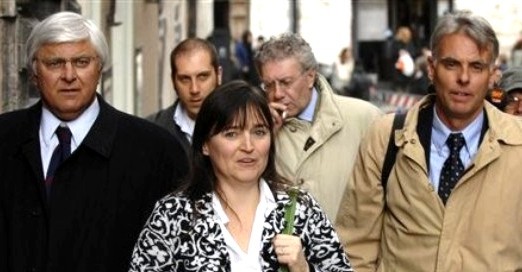
[Above: Knox’s legal team with mom back when; even then it looked like they could use some sleep]
Overview
Meeting in Seattle, Amanda Knox’S lawyer urges her to be at the Florence appeal, but his suggestion falls on deaf ears.
Here is a brief report from Italy. Clearly her lead defense lawyer Ghirga (who normally handles only small-time crime) thinks the presence of Knox and her entourage coould humanize her and allow her to speak out and to guide him.
But Knox has really been burning her bridges to Italy big-time. Let us list some of the ways in which they are now foolishly dug in so deep.
Further Law-Breaking
Since the end of trial in 2009 Amanda Knox’s entourage and she herself appear to have broken law after law after law, issuing new smears, harassing the victim’s family, having her book taken to court in Bergamo.
In Florence, how does she talk about that?
Evidence Could Strengthen
The evidence in the case as presented at trial in 2009 remains rock solid to this day (the Massei outcome is the state of play) and if the large knife is retested, it could actually get way worse. Hundreds of open questions remain which Knox has strenuously avoided answering, either on the stand or in her book or on TV.
In Florence, how does she talk about that?
Calunnias Of Justice Officials
Every instance where Amanda Knox and any of her entourage alleged without hard proof that Italian police and prosecutors have committed crimes (and there have been literally hundreds of such accusations by Preston, Fischer, on and on, now all captured and preserved) could see any or all of them hauled into court with zero heads-up (ask Sforza).
In Florence, how does she talk about that?
Framing Of Dr Mignini
In 2011 Knox was sentenced to three years (served) for the crime of framing Patrick Lumumba. So what does this slow learner do? Turn right around and commit the SAME crime in her nasty book, only this time she makes it worse. This time, she frames the chief prosecutor, in describing in detail a highly illegal interrogation that never took place.
In Florence, how does she talk about that?
Threat Of Conspiracists
There are perhaps 40 felony allegations against police and prosecution in Sollecito’s blood-money book and maybe another 20 in Knox’s own. Each of them will be put on trial separately for those claims and either one of them or both in desperation could take down all the writers, all the agents, all the publishers, all the wild-eyed conspiracists who helped write the books, and all those who made the illegal multi-million dollar deals, including their own two dads.
In Florence, how does she talk about that?
Threat Of Frank Sforza On Trial
The contempt of court trial of Frank Sforza is about to start. He is desperate to stay out of jail, and all of his alleged felonies since 2008 in contempt of the court could put him there for up to ten years. Consider the list of precisely who in Italy and the US Frank Sforza might take down, to try to give himself something of a break. This list is nothing if not long (see next post).
In Florence, how does she talk about that?
Threat Of Hellmann And Aviello
Witness Luciano Aviello is now on trial and as this post explained Aviello could take down all of the defense lawyers (for illegal dealing over the “right” judge), all of the Sollecitos, if they offered bribes, and both of the judges, Hellmann and Zanetti, who presided over the annulled appeal.
In Florence, how does she talk about that?
Conclusion
Nobody with any sense flouts the Supreme Court, or the extremely important, powerful court in Florence, which has sent down some of the toughest perps in the land.
Both courts and both prosecution teams are well-know in Italy for being cold and relentless in their search for the truth. None of the four lead lawyers for Sollecito and Knox has ever won even one case either in Florence or before the Supreme Court.
This might well be a trial balloon, to see how the Florence prosecutors and courts react. An arrest warrant, maybe? As we have seen lately, they act fast, and suddenly at any time.
Sunday, June 23, 2013
A Summary Of The Cassazione Ruling On Annulment Of The Knox-Sollecito Appeal
Posted by Machiavelli

[Above and below: justice-themed artwork in Cassazione; motifs are used all over the world]
1. Introduction
On June 18, 2013 the Supreme Court of Cassazione issued the official rationale for the sentence of annulment of the Hellmann-Zanetti verdict.
That verdict acquitted Amanda Knox and Raffaele Sollecito on the charge of murder and sexual violence, while finding Knox guilty of the crime of calunnia (obstruction of justice by maliciously placing false accusation against a person you know is innocent).
Previously I posted here a summary of the recourse to the Cassazione by the Umbria Prosecutor-General Dr. Galati and Prosecutor Dr. Costagliola which demanded an annulment of the appeal verdict. I also posted here a first summary report, from the March 25-26 Supreme Court hearing, when the Hellmann verdict was annulled and thus prosecution recourse was won.
The 74-page motivation report states clearly that Cassazione “accept the points of the recourse” from both the Prosecution and the Kercher parties, while they reject the Knox defense recourse.
While you will realize it yourself in reading it, I can say in advance that what the Supreme Court points out in the appeal verdict is a pattern of manifest violation of an unprecedented gravity. All those I know in the law professions have never seen, throughout their professional lives, a Cassazione bashing portraying such a concentration of flaws in one verdict.
Mostly written by Judge M. S Caprioglio (possibly including parts by Judge Severo Chieffi) the document features a sophisticated Italian language and a formal style.
The first half of the report is a summary of judicial events and arguments made by the parties through the previous instances. The second part basically dismantles all the points of reasoning of the Hellmann-Zanetti verdict, without spending too many words for each one of them.
2. A premise about the concept of legitimacy judgment
The second part is introduced by an explanation about what a “legitimacy judgment” is, about its scope and boundaries. The Court is called to assess 1) whether the judges of merit indicated reasons for their decisions, and 2) if reasons are logically argued and legally founded.
The meaning of “logically argued” is that the Court shall verify that the lower judge actually did take into consideration the evidence included in the trial file (“principle of completeness”), and if reasoning is consistent with them, and with the law. The Court “being a “court of legitimacy” [decides on legitimacy of the process that lead to conclusions, not on the merit] “does not assess directly the existence or the quality of the pieces of evidence, but may well assess the quality of reasoning about it and its actual consistence with the evidence in the file”.
So the legitimacy judges staying within their boundaries are not prevented from assessing whether the lower court followed logical criteria, meaning assessing if arguments used by the lower courts are plausible, as well as if their reasoning is “complete” and truthful with respect to the evidence file. The Supreme Court is also allowed to access the evidence trial documents for the parts that may conflict with the verdict conclusions.
The Court states that the present case is obviously based on circumstantial evidence, but points out how circumstantial evidence is not less powerful or logically less valuable than direct evidence.
While remaining within the boundaries of the legitimacy judgment, the Court notes anyway that at first sight in the Hellmann-Zanetti verdict there is an obvious “parceling out” of the pieces of circumstantial evidence. This means a lack of assessment also of each piece of circumstantial evidence, since the judge failed to check whether the possible flaws and lacks in the logical value of each single piece of evidence could be filled by crossing them and taking in account the whole set of them.
The Court also notes however that the judges’ conclusions also openly contradicted some of the pieces of evidence: they neglected or “overlooked” them in some cases, or dismissed some pieces on which the previous reasoning was based without offering adequate reasons. Moreover the pieces of evidence were also not “adequately elaborated”, and the pieces of reasoning about them were “not coordinated”.
3. The Amanda Knox calunnia
Reversing the order of topics from the Galati-Costagliola recourse, the Court deals first with the charge of calunnia for which Knox was convicted twice [obstructing justice by accusing a person who you know is innocent] (p. 41-44), since on this topic there is a converging of all recourses and unanimity by all judges. The appeal court had dismissed a possible link between the calunnia and the murder charges, but the explanation provided for that appears obviously illogical.
The Hellmann-Zanetti scenario - by which, they say, Knox may have voluntarily accused an innocent man just because she was pressed by investigators, thus for a purpose totally independent from the intent of obstructing the investigation on the charge of murder “is argued in a way that conflicts with and neglects the actual evidence documents”.
While Hellmann-Zanetti argue solely based on a police interrogation scenario as if the false accusation was an event confined within it, the Cassazione does not see Knox’s calunnia as a single event nor as a behavior limited to the situation of the interrogation, but rather as a prolonged behavior extending over a time of many hours and days (“perduranza in atteggiamento delittuoso”). Basically Knox goes on implicating Lumumba repeatedly, and she repeatedly provides false evidence, such as through her hand-written note “where she stands by what she declared” and by her subsequent behavior.
The Court also observes the evidence file contains evidence that was overlooked by Hellmann-Zanetti indicating Knox was aware that Lumumba was innocent, such as the recording of prison dialogues with her mother, where she says she feels guilty for having accused Patrick “a feeling of guilt implies an assumption that he was innocent”.
So the appeal court made mistakes because they lacked inference from pieces of evidence, mainly neglecting to argue elements like the discussion with her mother, her written memoir including the repetition of pieces of false testimony and her court admissions that she wrote her memoir voluntarily.
It points out (p.42) that Knox albeit young was a “mature” person meaning she had an adequate cultural level and education and would be able to regain control of herself afterward even if she had suffered a coercion or a moment of emotional breakdown. Knox would be basically able to understand the gravity of her declaration over a period of time.
If only one single event, such a false accusation caused by pressure, breakdown and stress could have been argued “in the abstract” in the way Hellmann-Zanetti did, considering the calunnia as a choice resulting from an episode of emotional breakdown, but the Hellmann-Zanetti reasoning neglects the actual documents and is not fit to explain the persisting and repeated false testimony.
The Supreme Court reminds that “information about commission of a crime” can be derived also from the interrogation of a police suspect, even from information released by a suspect who had not be read their rights under Art. 64, even from statements that are not usable for lack of defensive rights, and even that in the event the interrogation is to be nullified.
In all these cases the suspect commits a calunnia whenever he/she voluntarily and falsely accuses someone to defend himself/herself (so there can’t be any consequential link between the legal status of the interrogation, and the charge of calunnia or the collecting of information about a crime).
The Cassazione also points out that the Hellmann Zanetti rationale is illogical when it states that “the easiest way out” for one guilty “would have been to accuse the real author of the crime”. The inference obviously does not consider that she may be herself among the real authors of the crime (especially since she lived there and had access to the scene of crime).
The Court also points out the failure to properly address the importance of the details contained in the Knox false testimony (the detailing of this is in subsequent chapter).
4. The crime scene staging
The Cassazione accepts the Prosecution General point of recourse complaining about the failure to consider the evidence of staging a burglary, and says the recourse is “founded”. The pieces of physical evidence suggesting a staging are not satisfactorily argued or refuted by Hellmann-Zanetti.
The Hellmann-Zanetti appeal court also argued in favor of the “lone perpetrator scenario” by introducing some assertions which are unacceptable since they openly “collide” with the trial documents or are unfounded. Basically their reasoning was hinging on elements such as speculations about Guede’s personality, they introduced allegations like a purported habitual burglar profile, not backed by any evidence.
On the other hand they bring in arguments “like that about a glass shard in Meredith’s room” which have zero implications in their scenario (because they are equally good to argue in favor of a staging).
They should have argued “in favor or against” about evidence of burglary/staging based on the assessment of the pieces of physical evidence found on the scene, like argue against Massei’s reasoning about the ones mentioned in the first trial, say why it was not good. On the other hand the break-in scenario, as described by Hellmann-Zanetti, is affected by “multiple logical ruptures”, details are not explained consistently.
Moreover the Court says a scenario involving the issue of burglary/staging should be argued based on the overall evidence about Rudy Guede, meaning a scenario involving the whole of what he had done, like explain all the traces that show his movements, for example the trail of bloody shoe prints showing that he left the murder room straight away.
There are aspects of the reasoning that are “tautological” (circular and begging the question).
The Hellmann-Zanetti reasoning on the same point is also neglectful of part of the file sources (is based on a “partial access to information”), for example it overlook testimonies concerning wounds on Guede’s hands, dismissal of glass on top of items. To sum up, the rationale employs inadequate inferential principles and incorrect information.
5. Man in the park Curatolo’s testimony
Hellmann-Zanetti had dismissed the testimony of Antonio Curatolo.
Their statement about the reliability of Curatolo is totally “censurable”, since it is “apodictic” [assumed as a premise “true in advance” without explanation], and not based on thorough analysis of the data. In particular when they state that he tends to confuse days dates: such assertions are both unfounded and illogical since conflicting with the testimonies of himself and of others witnesses. The Court does not assess the reliability of Curatolo as a witness, but notes that the reasons brought by Hellmann-Zanetti are unacceptable.
The possibility to explain elements of the testimony by mistake of date by the witness, so placing his testimony possibly on Oct 31. is conflicting with the other evidence, namely the testimonies showing the defendants were elsewhere on the 31st. Moreover the elements used for the argument are logically weak compared to the strength of the elements showing Curatolo correctly “anchoring” his testimony to real events.
Then the lower court introduced “as further basis of reasoning” assertions in order to “jump” across the whole of Curatolo’s testimony: they based their conclusion on the asserted “decaying intellectual faculties”, on his use of heroin, and on his modus vivendi.
However they do not offer any element of evidence about the alleged mental decay, they fail to show this through analysis of his testimony, and in fact they completely fail to analyze the actual content and consistence of his testimony (lack of “completeness”). The use of heroin and his modus vivendi (as a “bum”) is also not acceptable as a reason for dismissing reliability of a witness, this would be an arbitrary judgment that violates the principles of witness assessment.
Since the witness was very assertive, consistent and felt certain about his testimony, the court would need a logically strong argument “based on some other finding or certainty” in order to dismiss his reliability (dislikes about his lifestyle or disproven speculations about date mistakes are not).
6. Shopkeeper Quintavalle’s testimony
The Court pretty quickly dismisses the Hellmann-Zanetti conclusions about Quintavalle, on grounds that they are based on a “cherry picking” and twisting of information from the documents, basically they misinterpret and neglect to consider the actual content of the Quintavalle’s testimony.
In fact the summary description of Quintavalle’s testimony that was offered by Hellmann-Zanetti is basically a misrepresentation based on incomplete parts of the testimony and overlooking of others, and flatly contradicts the content of actual testimony (it is not what Quintavalle and witnesses actually said).
It is not true that Quintavalle remembered about recognizing Knox one year later, documents show that he was sure about her identity from the early investigation - the Cassazione quotes some of Quintavalle’s statements where he remarks her circumstances and features.
Hellmann-Zanetti reported some bits of information in a fragmentary fashion without taking into account the explanations of Quintavalle and the answers he actually had given through the investigation.
The appeal court should have analyzed the whole of what the witness actually said, and crossed the statements with the existing information, instead of selecting cherry- picked bits and pinned on them a meaning out of context.
The Cassazione is not interested in assessing the reliability of the witness Quintavalle, but they find “intolerable” that Hellmann-Zanetti give a false picture of the testimony, in a way disjointed from the true content of the trial documentation.
7. The failure to consider implications of Knox’s memoir
The Prosecutor General was right in blaming the Hellmann-Zanetti court for neglecting to evaluate the hand written note written by Amanda Knox as a piece of circumstantial evidence. The appeal court dismissed the memoir as useless on the sole basis that it does not have a substantial meaning (actually: that it did not represent the truth).
But this argument is insufficient (and circular); it is also “structurally” inconsistent because the same Hellmann-Zanetti court used the very same note as a piece of evidence in the calunnia charge, and cannot be logically linked to pressure because she wrote it alone on her own initiative and not during an interrogation.
The Court details the content of the note pointing out that in the hand written memoir there is a repetition of some of the details from her previous “spontaneous statements”, which are now only set in an oneiric [dream-like, surreal] frame (they “seem unreal”) but yet they are the same peculiar details from the false accusation.
The Court also highlights the new “sibylline” [ambiguous and threatening] accusation by Knox against Sollecito (remembering blood on his hands, but probably from fish).
The next appeal court will need to build some actual arguments to explain these features, taking in account that “as for Hellmann-Zanetti” she wrote that while she was fully capable to understand and without any pressure from authorities.
The contradictory nature of the appeal court reasons on this point is “obvious”.
8. Failure to consider judicial files from Guede’s definitive sentencing
The Court spends a bit more than one page to explain why the prosecution recourse is correct in their complaint on this point as well. In fact Hellmann-Zanetti did accept the Guede verdict as a piece of circumstantial evidence, but argued that that piece was “particularly weak”.
However, the problem is that in reality they did not assess it at all in order to come to that conclusion, but they rather just completely ignored the whole content of the Guede verdict reports.
The court is not authorized to dismiss a piece of evidence which they formally entered without assessing it, just on “in limine” reasons. Therefore the decision openly “violates the law” (p. 55).
The Rudi Guede verdict motivations theoretically might be found “particularly weak” as a piece of circumstantial evidence, but it can’t be ruled “particularly weak” on the reasons declared by Hellmann-Zanetti.
The appeal court did not try to argue the logical passages of the Guede verdict in order to assess it and explain why conclusions were weak, instead they decided to ignore it, not based on the analysis of its content but instead based on the legal nature of the document. This is a patent violation of the law, and a conflict with the trial documents.
Thereafter the Hellmann-Zanetti court steered the discourse onto the alleged “habitual criminal” profile of Guede (an interpretation based on speculation) without explaining the reasons for building a scenario about Guede so far-fetched compared to the findings in the trial’s files about Guede.
Moreover the appeal court adds a further, false and illogical argument when they state that, even if Guede was proven to be guilty of concurring with others, this does not have implications for Knox and Sollecito at all because those accomplices could have been other people. The alleged lack of implication is false under logic, because determining that Guede acted together with others would additional information on the crime, which could be crossed with other information (such as about who had access to the apartment etc.).
The Court also remarks that the trials had found and explicitly declared Guede innocent of the crime of burglary, and the appeal court also fails to deal with this in their alternative scenario.
The appeal court also failed to consider other information from the findings of the Guede trial, and explicitly contradicted it without justification, for example they neglected to consider how the courts had determined through multiple witnesses that Guede actually did not have any injury on his hands on the night after the murder [Guede had cuts on his hand, but many days later, not the night after the murder].
9. Declarations of Rudy Guede at the Knox-Sollecito appeal
There is an open violation of the law in the Hellmann-Zanetti motivations, in the particular statement where they assert that Guede’s declarations in the courtroom were unreliable for the reason that he refused to undergo a questioning.
The reason brought by Hellmann-Zanetti to rule unreliability is illegitimate when referring to the specific declarations of Rudy Guede in the Knox-Sollecito appeal, and legally not true.
First, the Cassazione notes that the decision to refuse a questioning pertaining to a crime is within the rights of a witness who is implicated in the same crime. If the witness decided to invoke this right, the courts and the parties are bond to enforce it and limit their questions within topics unrelated to the crime, and under the law, no conclusion about reliability/unreliability can be drawn solely from the witness’s decision to refuse to answer about a topic in which he was implicated as a defendant.
No court could conclude that a witness is unreliable on the sole ground that he enforces his rights.
Moreover, preventing an interrogation of the witness on such topics is just a duty of the Prosecution and the Court, not a ruling “in favor” of the witness (and co-defendant).
The Prosecutor General had summoned Guede to testify only about the topic of things he said during conversation with inmates and letters he wrote from prison, and since the witness invoked his right as an ex co-defendant the Prosecutor General had the duty to enforce the limitations on his questioning.
It was the Sollecito-Knox defence attorneys who attempted to place questions directly on the topic of the events of Nov. 2, 2007, and they asked Guede to confirm the content of his letter directly pertaining the Kercher murder. The defence asked him to confirm if one particular statement of the letter he wrote was true, and the statement of Rudy Guede confirming his Knox and Sollecito implication and accusing them of murder was only in response to this, stemming from the defence question.
The declaration of Rudy Guede might be considered irrelevant as a piece of circumstantial evidence; and the witness might be assessed as unreliable by a court, but this cannot be done based on the illegitimate grounds brought by Hellmann-Zanetti. You cannot have, as an argument for unreliability, the fact that Rudy Guede chose the legal option of not undergoing a questioning about the murder.
The Cassazione also notes how the Hellmann-Zanetti report details some of Guede’s declarations in order to argue for his unreliability. However the cited statements from the Skype conversation with Giacomo Benedetti are used by Hellmann-Zanetti just to build an illogical argument: they say Rudy should have logically indicated the true culprits in that call, the fact that he does not accuse them is an indication that they were not there.
This argument is flawed (besides contradicting the very same claim about Guede’s unreliability). The Cassazione sees the weakness of reasoning about the Skype call as “symptomatic” of the lack of logical consistence of the appeal court on the topic of Rudy reliability, and it also reveals that the criteria they are following are not compatible with logic.
The appeal reasoning is also contradictory on further points, as Hellmann-Zanetti consider some declarations of Guede “reliable” without logical reason - like about the timing of death, where the appeal court considers Rudy’s statement reliable without considering that he had an obvious logical interest and an attitude of misleading the accusations by providing details that were conflicting with evidence.
Paradoxically, had the Hellmann-Zanetti court followed the same criteria on other declarations, they should have considered Guede’s declarations “reliable” when he says “Amanda is not implicated”, as well as when he says - talking about Sollecito - “I don’t know, I think it’s him” . The appeal court did not follow the principle of completeness and they did not consider these.
The Hellmann-Zanetti report also fails to consider that Guede was assessed as “totally unreliable” by his trial judges (they could have used such finding in documents to argue unreliability of his statements instead; if they had only read the Guede verdict). In other words they worked inconsistent arguments out of on an incomplete set of data.
10. The refusal to listen to the whole testimony of witness Luciano Aviello
The appeal trial was procedurally flawed also by the refused to call Luciano Aviello before the court again, as he was supposed to complete what was left out of his testimony.
Luciano Aviello was called as a witness by the court in accepting a defence request; after his hearing, during the course of the trial, new elements emerged “new witness declarations” that created a necessity to put some further questions to the witness.
The Hellmann-Zanetti court refuse to call back the witness to complete the questioning, despite that he had already been accepted as a witness by the same court. So the witness was basically prevented from completing his testimony.
The Cassazione does not argue about the reliability of Aviello as a witness (nor about the relevance of his testimony) but points the finger against the inconsistency of Hellmann-Zanetti’s ruling, which causes their decision to be illegitimate.
The refusal to call back the witness to complete his testimony at a second hearing was manifestly inconsistent, since that violates the principle of completeness (once you call a witness, you need to be ready to listen to all that he has to say).
The court’s decision was “unacceptable” (p. 58) also because it was based on arbitrary criteria - as Hellmann-Zanetti said “another hearing of the witness is not indispensable” on the ground that minutes of his interrogation were entered in the file: the decision violates the principles of usability of documents and the rules of witness hearing.
The appeal court completely ignored the reasons for and the new content of the topics Aviello was to be questioned about, and did not assess them. Instead, they violated articles 511, 511bis and 512 of the procedure code by “replacing” it with non-usable minutes of his interrogation.
The judgement of “non-indispensable” was also unfounded, manifestly so compared to the importance of the topic which referred to the explanation and completeness of Aviello’s testimony. A plot concerning a secret agreement in order to offer false declarations in court is obviously a topic with some relevance.
There is also a violation of the principle of confrontation, because Aviello was a defence witness and the Prosecutor General had the duty of carrying on an assessment of the witness within the appeal trial by cross examination (Hellmann-Zanetti’s decision allowed only the piece of testimony that could be favorable to the defence, and they cut off the part that could be unfavorable).
The motivation is also incomplete as Aviello is ruled “unreliable” a priori because of his retraction (which Hellmann-Zanetti apparently considered reliable) and irrelevant as a piece of evidence without actually listening to the content of his testimony, to what he had to say.
The testimony of Aviello could not be “cut off” that way and could not be considered unreliable a priori without listening to it.
11. The re-framing of the time of death
The Court devotes four pages to explaining how Hellmann-Zanetti’s reasoning about re-location of the time of death is illogical.
The appeal court refused to anchor the timing (and further features, noises etc.) of the screaming, to the time frame offered by two witnesses, Nara Capezzali and Antonella Monacchia. They also dismissed the testimony of Mrs. Dramis. Instead they accepted the defence idea of determining the time of death based on the statements by the “unreliable” Rudy Guede. They put the time of death in relation to the phone calls, around 9pm.
As for the Cassazione, such an argumentation path is woven through with “conjecture and illusions” (p. 61). The bases chosen for inference are devoid of any factual validity, as opposed to the elements of evidence which were discharged, which are instead extremely relevant.
The Hellmann-Zanetti report refutes the elements (testimonies of Capezzali, Damis, Monacchia) with arguments which are riddled with obvious, multiple inconsistencies [like the claim that a half-an-hour error would make the testimony unreliable, or that Nara’s looking unsure between the dates of Nov. 1. or 2. makes the scream attributable to something else, as if she was used to hearing blood-curdling screams every other day and as if the Monacchia confirmation testimony didn’t exist].
So the Hellmann-Zanetti rationale dismisses as “unreliable” or “useless” some very relevant and consistent testimonies (from witnesses they declare “credible”), while on the other hand, it accepts as “reliable” a dictum by Rudi Guede and builds a theory of the time of death on it - despite the defence itself having pointed out how Guede was totally unreliable and was also very able at changing and twisting every detail of his story, all the time and on any occasion, from the earliest stages of the investigation.
The Cassazione states - without any possibility of question - that it is manifestly obvious that things Guede consciously stated on the Skype conversation could never be used as the main credible source to build an inference about the time of death.
Moreover the Court points out that in fact the appeal court cherry picked just one statement by Guede, regarding the time of death, and considered it “credible”, while neglecting to note how within the same Skype conversation Guede also made a number of assertions about Knox
These included statements that place evidence against Knox and Sollecito. While in the same conversation Guede says “Amanda was not implicated”, he also states that Amanda was in the house; he states remembering that in Romanelli’s room the window appeared intact, and denied having broken it, he inferred that Knox and Sollecito must have done it; he also assumed that they must have altered the scene of the crime and the victim’s body; he also said he thought the man he saw was probably Sollecito.
The Hellmann-Zanetti court simply neglects to consider and deal with the whole information from the Skype call, which they instead elect to reliably source solely regarding Guede’s declaration about the time; so “besides illogicality in the unfounded dismissal of other testimonies” their method of processing information violates completeness and consistency.
The appeal court is also extremely weak where they try to fill the logical gap by drawing further inference from Meredith’s phone records. The attempt to link a mistaken phone call with the time of death is simply inherently implausible, a wrong call is a trivial event and there is no reason to make such link; also the delay by Meredith who did not call her mother again within the next half an hour is a trivial element which doesn’t have a specific implication upon the time of death.
The worst Hellmann-Zanetti did on this topic is the downplaying and underestimation of the testimonies of the three witnesses - Capezzali, Monacchia and Dramis.
In fact Capezzali described the scream in detail, picturing it with a number of features - “harrowing”, “unusual”, “long”, “isolated” and stressed its uniqueness and added additional information about noises (gravel path etc.) unequivocally linked to the cottage, she made clear that she never heard something similar before.
Monacchia was even more precise about the timing, since she went to sleep at 10.00 pm and slept for a while; Dramis came home back from the cinema at 10:30 pm. Their timings converge in placing the timing of an isolated scream later than 10:30 pm.
On the basis of Nara Capezzali’s testimony, it is absolutely unreasonable for the appeal court to assume that Nara could confuse the scream with the usual other “noises” of “junkies”.
Dramis as well referred to having been awaken by some noise of a kind she never heard before. Hellmann-Zanetti ruled out the time frame offered by the testimonies of Monacchia and Dramis for no reason except that they gave their testimony one year later; this is a totally insufficient and illogical reason.
As for considering Rudy as a reliable source, instead it is acknowledged that Guede was obviously lying and following a pattern of behavior/strategy of providing a flow of false details to muddle investigation.
The Court adds that neglecting the importance of information about the scream seems even more stunning when you consider the fact that the scream coincides with a detail that was mentioned in an early testimony of Knox [and even in declarations of Guede].
12. The court appointing of new experts and their management
This point may be the most interesting because it is the only topic on which the Supreme Court doesn’t agree entirely with the Prosecution General.
The Prosecution’s complaint was “˜partly’ correct about objecting to the legitimacy of the appeal court appointing new experts.
The point of recourse is founded insofar as the appointing was insufficiently motivated in the rationale: the reason expressed ““ basically addressing just the judge’s lack of scientific knowledge ““ is inconsistent, and also inadmissible because it violates the principle of non-delegation of judgment.
However, the judge’s decision of appointing experts itself should supposedly always be based on assessments of the merits of the evidence. The Cassazione cannot decide on the merits, so the decision about whether more expertise is necessary or not, which was supposedly taken based on the evidence available, is an exclusive competence of the judge of merit and the High Court can’t discuss it.
The absence of consistent motivations for the appointing reveals an insecurity of the appeal court about the evidence, which they (rightly or wrongly) attributed to incomplete information. However, the peculiar way the appeal court subsequently managed the experts is censurable.
The experts decided to not test the new DNA sample, despite the fact that the amount was 120 picograms [so much more than “˜5 picograms’ as declared by Vecchiotti in court, ed.], on an arbitrary decision by only one of the experts, on the ground that it was a “˜Low Copy Number’. Such a decision ““ itself unlawful ““ was subsequently subscribed to by the appeal court.
When the Prosecution General and consultant Prof. Novelli requested to go on testing the sample, since it was perfectly possible to do so, the court denied, arguing on the false assumption obtained by misquoting Novelli as saying the required techniques were “in the experimental phase”.
This was a misquote, a misinterpretation of a statement by Novelli, and the Court finds it to be false in the documentation: Hellmann-Zanetti incurred a gross misrepresentation of reality as they called the new technology “experimental” and “unreliable”.
Beside this false claim, it was on principle unacceptable that the expert Carla Vecchiotti refused to carry out a test, and that the judge accepted such a decision.
The expert’s decision violated the judge’s previous ordnance, because the written order said that they must require the court’s opinion before taking any decision, not after; the judge’s change also violated their own ordnance, because it withdrew from the previous tasking.
The modus operandi of the court therefore was to let an expert make decisions about their own mandate, based on their own judgment about the subsequent value of their finding in court.
But the experts had no authority to reduce or re-frame their own mandate, it is not up to them to preemptively decide whether their finding is reliable or not and anyway they cannot refuse to accomplish an order or to bring a finding into court; no matter if their finding is unreliable as a piece of evidence, they have to bring it anyway to court discussion, and its value will be determined through court discussion.
Hellmann-Zanetti were incomplete on documenting Novelli’s positions which were expressed during the experts’ testing and are in conflict with the Vecchioti-Conti decisions. They could have chosen Vecchiotti’s positions, but only after having dealt with the arguments expressed by the other side too.
The decisions by which Hellmann-Zanetti managed the experts’ work is also in violation of the principle of equality and the right of all parties to bring evidence, since they ordered a perizia [experts investigation] but then they prevented it from being fully accomplished: they only allowed the research activity by which the defence was seeking evidence, while they prohibited those activities requested by the accusation parties.
Once they ordered new scientific tests, the order should have been completed without any a priori unjustified preclusion. Their unbalanced modus operandi was an alteration of the evidence information set, and a violation of the law (p.66), and cause their motivations to be manifestly illogical.
13. The DNA evidence
The appeal court passively accepted the new experts’ conclusions, while ignoring the opinions of the witnesses Novelli and Torricelli. Their arguments had a comparable degree of importance, and the witnesses had at least the same degree of expertise and authority than the judge appointed experts.
As the judges chose to believe the conclusions of some experts in disagreement with others, they are not obligated to demonstrate themselves that such conclusions are true, but nonetheless they are required to report the arguments made by the other side and they need to deal with them in a reasoning.
This is especially necessary if the expert witnesses have a great expertise and credibility, at least comparable to that of the judge-appointed experts.
Hellmann-Zanetti accepted the C&V report entirely and passively, without confronting it with the opposite arguments and objections. Such procedure is illegitimate, since objections and arguments were not even mentioned.
The Casssazione recalls, among the not-mentioned and not-dealt-with arguments, that Prof. Novelli had calculated a probability of misinterpretation of the alleles on the bra-clasp; and Dr. Torricelli analyzed the Y-haplotype on 17 loci and found no match except Sollecito.
Novelli also testified that recommendations and protocols do exist, but the operator’s competence and common sense in scientific assessment is more important. He also said that the researcher should be always allowed to depart from standard procedures when single situations suggest so.
The judge-appointed experts themselves ruled out laboratory contamination. Novelli analyzed the series of samples from all 255 items processed and found not a single instance of contamination, and ruled out as implausible that a contaminating agent could have been present just on one single result.
Also Dr. Stefanoni testified that the knife was tested 6 days after an alleged contaminating and Vecchiotti confirmed that the time interval would lead to rule out laboratory contamination.
Hellmann-Zanetti also ignored or twisted information regarding the crime; it ignored the finding that no instance of Sollecito’s DNA was found on the scene as a possible contamination source despite may environmental samples; the High Court labels as false ““ going by the evidence file - Hellmann Zanetti’s statement saying that “everybody had walked around into the house”.
Also Cassazione notes that deterioration of an evidence scene due to time would normally cause a loss of DNA information, not an appearing of new information not found elsewhere.
So Hellmann-Zanetti did not take in account nor cite a huge part of the credited opinions and information; the total failure to mention such a major chunk of information by Hellmann-Zanetti makes their judgment about the topic illegitimate, and shows their “˜unacceptable’ modus operandi.
However the most surprising point of Hellmann-Zanetti ““ in the Cassazione’s view ““ is their uncritical accepting of the theory that contamination is “possible”, without linking the scenario of likeliness of contamination to any factual finding or datum. They actually built an axiom on a straining, a cherry picking and a falsifying of information.
The Court also reminds how Novelli testified that, in order to have a plausible scenario of contamination, you need to prove the existence of a source, of a vehicle of it.
They note from the documentation that negative control did exist, and that Vecchiotti & Conti were “˜superficial’ in assuming they did not exist just because they were not included in the technical report.
The Supreme Court then points out that:
(1) the collection of items was performed correctly contrarily to Hellmann’s suggestions, all activities of collection and laboratory tests were done before the eyes of defence experts, the environments were not contaminated, and the defence experts that were assisting did not raise any objection, they complained about things only much later;
(2) the arguments and explanations dr. Stefanoni subsequently gave were not adequately refuted;
(3) the picture of correctness in procedure causes the burden of proof in order to claim likeliness of contamination to rest squarely on the shoulders of those who claim it.
The law does not admit to set out the reasoning from a sheer “falsification” paradigm (meaning: it is wrong to assume that the prosecution has any burden to demonstrate the absence of contamination). Such an assumption would make it impossible to collect any piece of circumstantial evidence or do any scientific test at all.
The argument that the evidence should be dismissed as unreliable because contamination is “˜possible’ is totally illogical. You can’t dismiss pieces of evidence on the ground of a mere “˜possibility’ (or we should dismiss all pieces of evidence collected on all cases).
An alleged contamination event needs not to be only “˜possible’ (everything is possible), it needs to be “˜credible’. In order to consider if contamination was likely on a specific instance, some factual evidence of the specific causal circumstance is needed.
To bring a claim about “˜contamination’, while you don’t need to actually prove that the event of contamination occurred, you do need to prove a factual and scientific datum that would cause that specific contamination event to be “˜credible’ (probable).
In order to claim a contamination likely occurred, pointing at issues about professionalism of forensics is not enough. The factual existence of a specific “˜vehicle’ of contamination needs to be proven [like presence of a source, evidence of contamination in other results, explanation of the dynamic etc.].
To refute the scientific finding you need something much logically stronger than a complaint referring to ideal practice and protocols and the absolute generic concept of “˜possible’. The claim about a fact such as a specific instance of contamination requires “˜factual’ circumstances and data, “˜specific’ and “˜real’.
14. Analysis of prints and other traces
The objections by the Prosecution General on this topic are correct. The appeal court motivations manifestly lacks logical rigor in multiple instances.
The Court cannot object about the attribution of the bathmat print since the topic is strictly in the merit. But the implied scenario where Guede’s left shoe comes off after he walked on the pillow is implausible: it doesn’t explain why an Adidas shoe would come off, and it doesn’t reconcile with the evidence documentation.
Guede using the small bathroom to wash himself, and then locking Meredith’s door, is in conflict with the trail of shoeprints only showing him walking straight out. It makes no sense to assume that he lost a shoe just because there are blood prints of the right shoe alone.
About the luminol foot prints, it is implausible to assume that those prints were left on some other occasion, since ““ in the Court’s view - luminol basically indicates blood (and in no other circumstance could someone produce such a set of prints in blood). The Cassazione notes that the Massei scenario to explain the footprints was far more plausible, and Hellmann-Zanetti bring no reason to refute it.
The scenario described by the first instance trial court was also more complete, since it was able to connect the dots on several other details, including the “˜mixed traces’ of blood in the small bathroom, on the light switch, etc.
The only argument brought by Hellmann-Zanetti was the absence of Sollecito’s DNA from the blood/luminol stains. For the rest it was an “apodictic” assumption, so that they did not deal with the logical points that were made on the first instance.
15. The declarations of Ms. Knox
The Hellmann-Zanetti verdict was “˜critically’ flawed, as claimed by the Prosecution General, also on this point. This topic area falls into the big picture of parceling out of the pieces of evidence which was done by the appeal court.
The Supreme Court notes that Hellmann-Zanetti just assumed that there was no circumstantial evidence in Knox’s declarations, but they falsely implied that it was about behavioral and emotional evidence. Instead it was about Knox’s revealing a knowledge of details from the crime scene.
The Court mentions some of Knox’s statements conflicting with evidence and testimonies: she told Meredith’s friend of having found the body, she said it was before “˜a closet’, that it was covered, that Meredith had her throat cut and that she suffered a great blood loss. The first degree court reports Knox saying she didn’t see into the room, that she was far away in the corridor when it was opened.
Hellmann-Zanetti fail to mention this set of elements or clues, and they also neglect to consider the issue of Amanda’s phone call to her mother in the middle of the night and subsequent calls.
The Cassazione observes that Knox was unable to “˜remember’ the 12:47 phone call and did not explain its content; but Hellmann-Zanetti mistakenly considered such a phone call as occurring “˜at the same time’ of Sollecito’s calls to her sister and to the Carabinieri. In fact ““ the Court notes ““ Knox called her mother three minutes before Sollecito called his sister, she was first person to make any phone calls.
So Knox’s “˜downplaying’ of her phone call ““ her suggesting a total vague content, a sense of confusion and nothing important ““ and the early time of it, are not considered details worth of mention by the Hellmann-Zanetti court, and they are not put in relation to Knox’s inside knowledge about details of the crime (if she didn’t know anything at all, why does she call her mother to express vague confusion, worried about something she doesn’t know?).
What the Court finds objectionable is that Hellmann-Zanetti simply made assertions and steered on, talking about the subjective emotional reactions, without confronting any logical argumentation made by the lower court, and they failed to do anything to demolish the first instance reasoning.
16. Final indications
The Hellmann-Zanetti verdicts are annulled. The new appeal court will have to fix all the critical legitimacy flaws pointed out following the Cassazione indications.
The new appeal Judges will have to assess the pieces of circumstantial evidence in a global an unitary way, to assess whether the relative ambiguity of each piece of evidence can be overcome by the overall system between them.
The result of such an assessment will have to lead to a decision not only about the presence of Knox and Sollecito on the murder scene, but also about their possible roles in the crime, and to decide among an array of possible scenarios: from a premeditated intent to kill to possible scenarios that may involve a non-premeditated decision to murder as a departure from an original plan to have a non-consensual sex game, or involve a forced sex game that run out of control, or a similar situation.
The recourse submitted by Knox on the point of her conviction for calunnia is rejected. All points of recourse 1-10 by the Prosecution General are accepted, the appeal trial is annulled on grounds of manifest illogicality, inconsistence and violation of law for all conclusions of acquittal; instead, the conviction for the charge of calunnia stands, but the denial of aggravation in finding it not-linked to the murder is annulled.
Knox is condemned to pay the legal expenses sustained by the State and by Lumumba. If found guilty, Knox and Sollecito will have to pay also the expenses sustained by the Kerchers.
17. Considerations arising from the report
My final thoughts. Since the appeal verdicts were annulled, the legal situation is that Knox and Sollecito stand currently convicted in first degree and awaiting the appeal, which they had launched against their convictions.
They had already got a fair trial, before a court presided over by Massei; now they are appealing the verdict in a Florentine court. An appeal ““ under the Italian criminal procedure ““ can take the shape of a new trial ““ usually, partly ““ and so open again sessions where witnesses are heard and evidence are entered.
However, in many cases this doesn’t happen, and the appeal doesn’t look like a full trial. Anyway, even if the trial phase is re-opened, what may look like a trial de novo is in fact only an extension of the previous one; meaning: the trial de novo in fact doesn’t start from scratch, but starts from the documentation already existing and incorporates the previous proceedings.
The main piece of documentation now incorporated is the 2013 Supreme Court verdict.
Whatever appeal court deals with the Knox-Sollecito proceedings, they will have to set it within the guidelines, limitations and indications established by the Cassazione.
The Cassazione has dismantled and declared illegitimate all the procedural points by which Hellmann-Zanetti had come to verdicts of acquittals on the charge of murder. This shows how the appeal judgment was obtained only thanks to a dreadful series of procedure errors.
Unfortunately, actually not all errors in the Hellmann-Zanetti rationale could fall under the radar of the supreme court. The appeal court didn’t make only legitimacy errors, they also committed obvious mistakes in the merit of evidence assessment (and, not even all legitimacy issues were actually brought to the attention of the Supreme Court of Cassazione).
Examples of mistakes in the merits by Hellmann-Zanetti: they attributed the bathmat footprint on two unproven assumptions:
(1) The first was that the person who left it must have got his foot wet with blood by walking on a hard, flat surface smeared with blood; an obviously unfounded assumption, actually proven false since there was no hard flat surface covered in blood where anyone had walked (blood got on the murderers feet from soaked towels).
(2) The second ““ idiotic ““ “˜reason’ was the observation that Sollecito’s toe in the sample print looked more triangular (!) than the bathmat print’s (it is actually obvious that any object would leave a print with slightly more rounded shape on the bathmat compared to the sample paper, since the bathmat is a soft surface).
Another one was the claim that the pattern of footprints in luminol could be found in any apartment and be produced in any innocent situation (in a non-blood substance) but somehow they “˜forgot’ to mention what kind of likely substance that could be, and what plausible dynamic - except shuffling on rags or mat ““ could have produced them.
Flaws in the rationale and procedure are surreal, like maintaining that Knox’s written memoir is not evidence that she lied because its content is false. Or appointing experts to test DNA samples, then refusing to test the sample despite it’s being more than 120 picograms.
Even kids could spot the obvious logical errors on evidence assessment in the Hellmann-Zanetti rationale.
The refrain of factual errors and legitimacy/procedure violations is so serious that I can hardly believe any Magistrate of the Republic can make such errors in good faith.
Despite the sophisticated and formal language, as you may have understood from this summary, the Cassazione arguments are actually very simple. In fact the errors were very clear and obvious from the beginning - to quote PMF poster Popper “even a child would notice them immediately” - that in fact the Supreme Court looks like pointing the finger at a naked emperor.
The present Cassazione ruling does not leave any realistic hope for Knox and Sollecito to be acquitted on appeal. They have a right to appeal under Italian law. Though their appeal, when carried on within the rules and principles of law, looks ““ like most appeals ““ basically desperate.
Their actual chances of being acquitted by a Florentine court look essentially zero, because the court won’t be allowed to employ the key arguments and the path of reasoning followed by Hellmann-Zanetti to come to an acquittal verdict; all these logical tools are illegitimate, and hardly any judge could fix them, nor come to a “˜not guilty’ verdict by following other logical ways.
The only positive legal outcome in realistic terms for Knox and Sollecito now consists in seeking leniency or lesser charges based on claiming minor roles, maybe even by attempting to accuse each other.
Either that or testifying to the truth, seeking mitigating factors like psychological state and age, or showing remorse.
Sunday, June 16, 2013
Questions For Knox: Do You Really Think “False Memories” Claim Framing Italians Yet Again Will Help?
Posted by Our Main Posters

[You say Madison Paxton found Kassin? So why did Bruce Fischer and Sarah claim to have done so??]
1. Your Real Persona, Widely Observed
Remember that Italians have seen a lot more of the real you than most Americans ever have. Italians all saw the real you described here and here.
That is why maybe 95% of all Italians long ago concluded for your guilt. At times you can come across as winning but, as there on the stand, too often as brash, sneering, sharp-elbowed, humorless, uncaring, and self-absorbed.
That is the Knox that put off many who encountered you in Seattle, it is why you had Halloween largely alone, and why you put off almost everyone you encountered in Perugia. Including everyone in your house in Perugia, and most in Patrick’s bar - and this literally in less than a month.
The “lost little girl” persona, the “chaste girl who never did sex and drugs” persona, the “diligent girl who studied so hard” persona, and the “they all want to get me because I am so fantastically cute” persona you or your agenda-driven shadow-writer put in the book have many people who have seen a lot of you in strong disbelief.
Can you name even one good friend who still stands by you in Perugia, given that even Raffaele Sollecito has placed you at the brink of a cliff?
By the way, this is not an unkind group, mostly comprised as it is of professionals, and some surprising things you yourself said in your book confirmed a suspicion about untreated root causes that we mentioned here.
2. Pages 270 to 272 Of Your Book With Your False Claims Highlighted
Let us first quote what you claim about your interrogation as “explained” by Saul Kassin who had at this point diagnosed you only long-distance and talked with not even one person who was there. False claims are shown in bold.
Thankfully Madison had researched the science on false confessions. She found Saul Kassin, a psychologist at John Jay College of Criminal Justice in New York. A specialist in wrongful convictions, he took the mystery out of what had happened to me.
Before my interrogation, I believed, like many people, that if someone were falsely accused, they wouldn’t, couldn’t, be swayed from the truth while under interrogation. I never would have believed that I could be pressured into confessing to something I hadn’t done. For three years I berated myself for not having been stronger. I’m an honest person. During that interrogation, I had nothing to hide, and a stake in the truth “” I desperately wanted the police to solve Meredith’s murder. But now I know that innocent people often confess. The records kept of people convicted of a crime and later exonerated by DNA evidence show that the DNA of 25 percent of them didn’t match the DNA left at the scene. The DNA testing showed that one in four innocent people ended up confessing as I did. And experts believe that even more innocent people confess, both in cases with and without DNA evidence.
According to Kassin, there are different types of false confessions. The most common is “compliant,” which usually happens when the suspect is threatened with punishment or isolation. The encounter becomes so stressful, so unbearable, that suspects who know they’re innocent eventually give in just to make the uncomfortably harsh questioning stop. “You’ll get thirty years in prison if you don’t tell us,” says one interrogator. “I want to help you, but I can’t unless you help us,” says another.
This was exactly the good cop/bad cop routine the police had used on me.
Besides being compliant, I also showed signs of having made an “internalized” false confession. Sitting in that airless interrogation room in the questura, surrounded by people shouting at me during forty-three hours of questioning over five days, I got to the point, in the middle of the night, where I was no longer sure what the truth was. I started believing the story the police were telling me. They took me into a state where I was so fatigued and stressed that I started to wonder if I had witnessed Meredith’s murder and just didn’t remember it. I began questioning my own memory.
Kassin says that once suspects begin to distrust their own memory, they have almost no cognitive choice but to consider, possibly accept, and even mentally elaborate upon the interrogator’s narrative of what happened. That’s how beliefs are changed and false memories are formed.
That’s what had happened to me.
I was so confused that my mind made up images to correspond with the scenario the police had concocted and thrust on me. For a brief time, I was brainwashed.
Three years after my “confession,” I’d blocked out some of my interrogation. But the brain has ways of bringing up suppressed memories. My brain chooses flashbacks””sharp, painful flashes of memory that flicker, interrupting my conscious thoughts. My adrenaline responds as if it’s happening in that moment. I remember the shouting, the figures of looming police officers, their hands touching me, the feeling of panic and of being surrounded, the incoherent images my mind made up to try to explain what could have happened to Meredith and to legitimize why the police were pressuring me.
This new knowledge didn’t stop my nightmares or flashbacks, but I was so relieved to learn that what I’d been through wasn’t unique to me. It had been catalogued! It had a name! As soon as I understood that what happened during my interrogation wasn’t my fault, I started forgiving myself.
Kassin and others show that interrogations are intentionally designed to bewilder and deceive a suspect. Originally created to get highly trained, patriotic U.S. fighter pilots to sell out their country during the Korean War, one technique uses a tag team of investigators and tactics meant to induce exhaustion, agitation, and fear. It’s especially potent on young, vulnerable witnesses like me. The method was designed not to elicit information but to plant it “” specifically tailored to destroy an orderly thought process. After some hours, the subject gives the interrogators what they want “” whether it’s the truth or not.
In my case they’d put several interrogators in a room with me. For hours they yelled, screamed, kept me on edge. When they exhausted themselves, a fresh team replaced them. But I wasn’t even allowed to leave to use the bathroom.
These were strategic measures, many of which are described in Kassin’s report on police interrogation, “On the Psychology of Confessions: Does Innocence Put Innocents at Risk?” Reading it, I was flabbergasted to learn how by the book the police had been in their manipulation of me.
It had been the middle of the night. I’d already been questioned for hours at a time, days in a row. They tried to get me to contradict myself by homing in on what I’d done hour by hour, to confuse me, to cause me to lose track and get something wrong. They said I had no alibi. They lied, saying that Raffaele had told them I’d asked him to lie to the police. They wouldn’t let me call my mom. They wouldn’t let me leave the interrogation room. They were yelling at me in a language I didn’t understand. They hit me and suggested that I had trauma-induced amnesia. They encouraged me to imagine what could have happened, encouraged me to “remember” the truth because they said I had to know the truth. They threatened to imprison me for thirty years and restrict me from seeing my family. At the time, I couldn’t think of it as anything but terrifying and overwhelming.
That was exactly their point.
Highlighted in bold is another large body of your many easy-to-disprove lies as in the previous post.
Your bizarre analysis leads to many many questions.
- What honest person? You served three years for felony lying. Exactly how did you ever help the police? What good cop/bad cop routine? There were only ever 2 or 3 interviewers there. What airless room? You were in a very modern building with air conditioning. What shouting? What 43 hours of interrogation? You had at most been questioned for one or two hours - and only for a few minutes on this night when you “broke”. What story were police forcing on you? Why were you so confused and stressed - other than that Sollecito had just left you with no alibi? What did the police concoct and thrust on you, and why? Why didnt they do that to anyone else? So many others were interviewed too.
You are not even in Kassin’s “vulnerable” target group. How could you possibly be brainwashed in such a short time? What do you mean “after some hours”? What hours? Who exactly yelled and screamed and kept you on edge? What fresh tag team? Who stopped you leaving the interrogation room for a bathroom break? Why did you testify that you were given refreshments and treated well? Why did your own lawyers say you were treated well? Why did they never lodge a complaint? Why when you had an excellent interpreter did you say you couldn’t understand? Why would police threaten to imprison you for 30 years when their whole interest moved quickly to Patrick as you engineered? And why after the interview when you were left sitting in a corridor, babbling and being calmed down, did you not simply walk right out?
In fact, nobody ever accused you of anything at all in your voluntary witness interview.
You were put under no pressure to confess. Not so long after Sollecito fingered you, you spontaneously blamed Patrick for Meredith’s death. For the next several hours, you babbled on, again and again blaming Patrick. Dr Mignini then witnessed you being warned, and barely said a word.
And of course you never ever did confess that you participated in the attack on Meredith yourself. You are really claiming a false confession - when you didnt even confess?
Sollecito similarly cracked spontaneously in an adjacent room, and he pointed the blame at you. Its very noticeable in all of the above that you essentially dont even mention his name. Nor does Kassin.
So what made Sollecito crack? You don’t explain that.
3. Saul Kassin’s Version with His False Claims Highlighted
It seems that Kassin was subjected to the toxic Misinformation Cloud conjured up by the Rank Amateurs for Knox, and Kassin very foolishly failed to check with anyone at all who had been on the spot.
Here are the relevant passages from Saul Kassin’s paper in American Psychologist with his false claims highlighted in bold.
As illustrated by the story of Amanda Knox and many others wrongfully convicted, false confessions often trump factual innocence. Focusing on consequences, recent research suggests that confessions are powerfully persuasive as a matter of logic and common sense; that many false confessions contain richly detailed narratives and accurate crime facts that appear to betray guilty knowledge; and that confessions in general can corrupt other evidence from lay witnesses and forensic experts””producing an illusion of false support. This latter phenomenon, termed “corroboration inflation,” suggests that pretrial corroboration requirements as well as the concept of “harmless error” on appeal are based on an erroneous presumption of independence among items of evidence. In addition to previously suggested reforms to police practices that are designed to curb the risk of false confessions, measures should be taken as well to minimize the rippling consequences of those confessions….
Meredith Kercher was found raped and murdered in Perugia, Italy. Almost immediately, police suspected 20-year-old Amanda Knox, an American student and one of Kercher’s roommates””the only one who stayed in Perugia after the murder. Knox had no history of crime or violence and no motive. But something about her demeanor””such as an apparent lack of affect, an outburst of sobbing, or her girlish and immature behavior”” led police to believe she was involved and lying when she claimed she was with Raffaele Sollecito, her new Italian boyfriend, that night.
Armed with a prejudgment of Knox’s guilt, several police officials interrogated the girl on and off for four days. Her final interrogation started on November 5 at 10 p.m. and lasted until November 6 at 6 a.m., during which time she was alone, without an attorney, tag-teamed by a dozen police, and did not break for food or sleep. In many ways, Knox was a vulnerable suspect””young, far from home, without family, and forced to speak in a language in which she was not fluent. Knox says she was repeatedly threatened and called a liar. She was told, falsely, that Sollecito, her boyfriend, disavowed her alibi and that physical evidence placed her at the scene. She was encouraged to shut her eyes and imagine how the gruesome crime had occurred, a trauma, she was told, that she had obviously repressed. Eventually she broke down crying, screaming, and hitting herself in the head. Despite a law that mandates the recording of interrogations, police and prosecutors maintain that these sessions were not recorded.
Two “confessions” were produced in this last session, detailing what Knox called a dreamlike “vision.” Both were typed by police””one at 1:45 a.m., the second at 5:45 a.m. She retracted the statements in a handwritten letter as soon as she was left alone (“In regards to this “˜confession’ that I made last night, I want to make it clear that I’m very doubtful of the verity of my statements because they were made under the pressures of stress, shock, and extreme exhaustion.”). Notably, nothing in the confessions indicated that she had guilty knowledge. In fact, the statements attributed to Knox were factually incorrect on significant core details (e.g., she named as an accomplice a man whom police had suspected but who later proved to have an ironclad alibi; she failed to name another man, unknown to police at the time, whose DNA was later identified on the victim). Nevertheless, Knox, Sollecito, and the innocent man she implicated were all immediately arrested. In a media-filled room, the chief of police announced: Caso chiuso (case closed).
Police had failed to provide Knox with an attorney or record the interrogations, so the confessions attributed to her were ruled inadmissible in court. Still, the damage was done. The confession set into motion a hypothesis-confirming investigation, prosecution, and conviction. The man whose DNA was found on the victim, after specifically stating that Knox was not present, changed his story and implicated her while being prosecuted. Police forensic experts concluded that Knox’s DNA on the handle of a knife found in her boyfriend’s apartment also contained Kercher’s blood on the blade and that the boyfriend’s DNA was on the victim’s bra clasp. Several eyewitnesses came forward. An elderly woman said she was awakened by a scream followed by the sound of two people running; a homeless drug addict said he saw Knox and Sollecito in the vicinity that night; a convicted drug dealer said he saw all three suspects together; a grocery store owner said he saw Knox the next morning looking for cleaning products; one witness said he saw Knox wielding a knife.
On December 5, 2009, an eight-person jury convicted Amanda Knox and Raffaele Sollecito of murder. The two were sentenced to 26 and 25 years in prison, respectively. Finally, on October 3, 2011, after having been granted a new trial, they were acquitted. [Actually they still stand accused - and facing a tough fact-based prosecution appeal] Ten weeks later, the Italian appeals court released a strongly worded 143-page opinion in which it criticized the prosecution and concluded that there was no credible evidence, motive, or plausible theory of guilt. For the four years of their imprisonment, this story drew international attention (for comprehensive overviews of the case, see Dempsey, 2010, and Burleigh, 2011).1
It is now clear that the proverbial mountain of discredited evidence used to convict Amanda Knox and Raffaele Sollecito was nothing but a house of cards built upon a false confession. The question posed by this case, and so many others like it, is this: Why do confessions so often trump innocence? ...
Third, it is important to realize that not all evidence is equally malleable or subject to corroboration inflation. Paralleling classic research indicating that expectations can color judgments of people, objects, and other stimuli that are ambiguous as opposed to those that compel a particular perception, forensic research indicates that ambiguity is a moderating condition. Asked to report on an event or make an identification decision on the basis of a memory trace that cannot be recovered, eyewitnesses are particularly malleable when confronted with evidence of a confession (Hasel & Kassin, 2009). This phenomenon was illustrated in the case against Amanda Knox. When police first interviewed Knox’s British roommates, not one reported that there was bad blood between Knox and the victim. After Knox’s highly publicized confession, however, the girls brought forth new “memories,” telling police that Kercher was uncomfortable with Knox and the boys she would bring home (Burleigh, 2011). ...
In recent years, psychologists have been critical of the problems with accuracy, error, subjectivity, and bias in various types of criminal evidence””prominently including eyewitness identification procedures, police interrogation practices, and the so-called forensic identification sciences, all leading Saks and Koehler (2005) to predict a “coming paradigm shift.” With regard to confessions, it now appears that this shift should encompass not only reforms that serve to minimize the risk of false confessions but measures designed to minimize the rippling consequences of those confessions””as in the case of Amanda Knox and others who are wrongfully convicted.
4. An Exposure Of Ten Of Saul Kassins’s False Claims
Our main poster the Machine exposes further how Kassin’s key claims are wrong.
False Claim 1: They brought her in for that final interrogation late at night.
No they didn’t.
Neither the police nor the prosecutors brought Amanda in for questioning on 5 November 2007. Amanda Knox herself testified in court that she wasn’t called to come to the police station on 5 November 2007.
Carlo Pacelli: “For what reason did you go to the Questura on November 5? Were you called?”
Amanda Knox: “No, I wasn’t called. I went with Raffaele because I didn’t want to be alone.”
Amanda Knox went with Raffaele Sollecito because she didn’t want to be alone. Kassin’s false claim is the first red flag that Saul Kassin is very confused or has been seriously misled when it comes to this well-documented and well-handled case.
False Claim 2: The so-called confession wasn’t until 6:00am.
No it wasn’t.
If Saul Kassin had actually read Amanda Knox’s first witness statement, he would have known that it was made at 1:45am. Knox had admitted that she was at the cottage when Meredith was killed some time before this.
False Claim 3: She was interrogated from 10:00pm to 6.00am.
No she wasn’t.
According to the Daily Beast Amanda Knox’s questioning began at about 11:00pm.
Since Knox was already at the police station [in the company of Raffaele Sollecito] the head of the murder squad decided to ask her a few questions. Her interrogation started at about 11 p.m.
After Amanda Knox had made her witness statement at 1:45am, she wasn’t questioned again that evening. That was it.
However, Amanda Knox herself then wanted to make further declarations and Mr Mignini who was on duty on the night sat and watched while Knox wrote out her declarations.
Mr Mignini explained what happened in his email letter to Linda Byron, another who was factually challenged.
All I did was to apply the Italian law to the proceedings. I really cannot understand any problem.
In the usual way, Knox was first heard by the police as a witness, but when some essential elements of her involvement with the murder surfaced, the police suspended the interview, according to Article 63 of the penal proceedings code.
But Knox then decided to render spontaneous declarations, that I took up without any further questioning, which is entirely lawful.
According to Article 374 of the penal proceedings code, suspects must be assisted by a lawyer only during a formal interrogation, and when being notified of alleged crimes and questioned by a prosecutor or judge, not when they intend to render unsolicited declarations.
Since I didn’t do anything other than to apply the Italian law applicable to both matters, I am unable to understand the objections and reservations which you are talking about.
In Amanda Knox’s written witness statement, she explicitly states that she’s making a spontaneous declaration:
Amanda Knox: “I wish to relate spontaneously what happened because these events have deeply bothered me and I am really afraid of Patrick, the African boy who owns the pub called “Le Chic” located in Via Alessi where I work periodically.
False Claim 4: They banged her on the back of the head.
No they didn’t.
All the numerous witnesses who were actually present when Amanda Knox was questioned, including her interpreter, testified under oath at trial in 2009 that she wasn’t hit. She has never identified anyone who hit her and on several occasions confirmed that she was treated well.
Even one of Amanda Knox’s lawyers, Luciano Ghirga, confirmed that Amanda Knox had not been hit: “There were pressures from the police but we never said she was hit.” He never ever lodged a complaint.
False Claim 5: All the other British roommates left town.
No they didn’t.
The police also told Sophie Purton that they needed her to stay on in Perugia on precisely the same basis as Amanda Knox. In chapter 19 of Death in Perugia, John Follain states that Sophie Purton was questioned by Mignini and Napoleoni in the prosecutor’s office on 5 November 2007.
Sophie had been counting on leaving Perugia to fly back home as soon as her parents arrived, but the police called to tell her they needed her to stay on; they would let her know when she could leave.
False Claim 6 : Amanda Knox stayed back to help the police.
No she didn’t.
This claim is flatly contradicted by Amanda Knox herself. In the e-mail she wrote to her friends in Seattle on 4 November 2007 she categorically stated she was not allowed to leave Italy.
i then bought some underwear because as it turns out i wont be able to leave italy for a while as well as enter my house
Knox actually knew on 2 November 2007 that she couldn’t leave Italy. Amy Frost reported the following conversation (The Massei report, page 37),
I remember having heard Amanda speaking on the phone, I think that she was talking to a member of her family, and I heard her say, No, they won’t let me go home, I can’t catch that flight.
It’s not the first time that the myth that Knox chose to stay behind rather than leave Italy has been claimed in the media. And incidentally, lying repeatedly to the police isn’t normally considered to be helping them.
False Claim 7: Amanda Knox had gone 8 hours without any food or drink.
No she hadn’t.
Reported by Richard Owen in The Times, 1 March 2009
Ms Napoleoni told the court that while she was at the police station Ms Knox had been ‘treated very well. She was given water, camomile tea and breakfast. She was given cakes from a vending machine and then taken to the canteen at the police station for something to eat.’
Reported by Richard Owen in The Times, 15 March 2009.
Ms Donnino said that Ms Knox had been “comforted” by police, given food and drink, and had at no stage been hit or threatened.
John Follain in his meticulous book Death in Perugia, page 134, also reports that Knox was given food and drink during her questioning:
During the questioning, detectives repeatedly went to fetch her a snack, water, and hot drinks including camomile tea.
False Claim 8: The translator was hostile towards Amanda Knox.
No she wasn’t.
Saul Kassin offers no evidence that the translator was hostile towards Amanda Knox and there is no evidence that this was the case. Nobody at the questura has claimed this. Amanda Knox’s own lawyers have not claimed this.
Even Amanda Knox herself has never ever claimed that Anna Donnino was hostile towards her although she had every opportunity to do so when being questioned on the stand.
False Claim 9: The translator was acting as an agent for the police.
No she wasn’t.
Saul Kassin offers no evidence to support this claim, which by the way in Italy is the kind of unprofessional charge that incurs calunnia suits. Do ask Curt Knox.
False Claim 10: The police lied to Amanda Knox.
No they didn’t.
The police didn’t mislead Amanda Knox. They told her quite truthfully that Sollecito was no longer providing her with an alibi, and that he had just claimed in the next interrogation room that she wasn’t at his apartment from around 9:00pm to about 1:00am. This also is the kind of unprofessional charge that incurs calunnia suits
Other claims by Kassin are also inaccurate. He claims that not one of your acquaintances had reported there was bad blood. That also is untrue. Even prior to the witness interrogation, law enforcement knew from multiple sources that you had been feuding with just about everyone. Acquaintances created no “new memory”. The bad blood you created was quite real.
5. How Kassin Bends His Own Science To Make Results Come Out “Right”
Our main poster Fuji dug deeper into the science and turns up what is an obvious scientific fraud by Kassin to insert himself into the case.
Meredith’s case is absolutely riddled with fabricated false myths.
They are now found by the hundreds on some misleading websites, and they simply make experienced law enforcement and criminal lawyers laugh.
For example “Police had no good reason to be immediately suspicious of Knox simply because the murder occurred at her residence”. And “The double-DNA knife is a priori to be disregarded as evidence, because no murderer would retain possession of such a murder weapon.”
One of the most strident and widespread myths is that Amanda Knox’s statements to the Perugian investigators on 5 and 6 November 2007, placing her at the scene of Meredith’s murder, are to be viewed as the products of a genuinely confused mind imbued with a naïve trust of authority figures.
The apparent certainty with which many of Amanda Knox’s most vocal supporters proclaim that Knox’s statements are actual “false confessions” as opposed to deliberate lies is not supported by even a cursory reading of the pertinent academic literature regarding false confessions.
What actually are “false confessions”?
Richard N. Kocsis in his book “Applied Criminal Psychology: A Guide to Forensic Behavioral Sciences” (2009), on pages 193-4 delineates three different kinds of false confessions:
First, a voluntary false confession is one in which a person falsely confesses to a crime absent any pressure or coercion from police investigators….
Coerced-compliant false confessions occur when a person falsely confesses to a crime for some immediate gain and in spite of the conscious knowledge that he or she is actually innocent of the crime….
The final type, identified by Kassin and Wrightsman (1985), is referred to as a coerced-internalized false confession. This occurs when a person falsely confesses to a crime and truly begins to believe that he or she is responsible for the criminal act.
The first problem facing Knox supporters wishing to pursue the false confession angle as a point speaking to her purported innocence is epistemological.
Although much research has been done on this phenomenon in recent years, academics are still struggling to come to terms with a methodology to determine their incidence rate.
The current state of knowledge does not support those making sweeping claims about the likelihood of Knox’s statements being representative of a genuine internalized false confession.
As noted by Richard A. Leo in “False Confessions: Causes, Consequences, and Implications” (Journal of the American Academy of Psychiatry and the Law, 2009):
Although other researchers have also documented and analyzed numerous false confessions in recent years, we do not know how frequently they occur. A scientifically meaningful incidence rate cannot be determined for several reasons.
First, researchers cannot identify (and thus cannot randomly sample) the universe of false confessions, because no governmental or private organization keeps track of this information.
Second, even if one could identify a set of possibly false confessions, it is not usually possible as a practical matter to obtain the primary case materials (e.g., police reports, pretrial and trial transcripts, and electronic recordings of the interrogations) necessary to evaluate the unreliability of these confessions.
Finally, even in disputed confession cases in which researchers are able to obtain primary case materials, it may still be difficult to determine unequivocally the ground truth (i.e., what really happened) with sufficient certainty to prove the confession false.
In most alleged false-confession cases, it is therefore impossible to remove completely any possible doubts about the confessor’s innocence.
The next problem Knox supporters face is that, even allowing for an inability to establish a priori any likelihood of a given statement being a false confession, the kind of false confession which is usually attributed to Knox is in fact one of the LEAST likely of the three types (Voluntary, Compliant, and Persuaded, as Leo terms the three different categories) to be observed:
Persuaded false confessions appear to occur far less often than compliant false confessions.
Moreover, despite assertions to the contrary, Knox and her statements do not in fact satisfy many of the criteria researchers tend to observe in false confessions, particularly of the Persuaded variety:
“All other things being equal, those who are highly suggestible or compliant are more likely to confess falsely. Individuals who are highly suggestible tend to have poor memories, high levels of anxiety, low self-esteem, and low assertiveness, personality factors that also make them more vulnerable to the pressures of interrogation and thus more likely to confess falsely…
Highly suggestible or compliant individuals are not the only ones who are unusually vulnerable to the pressures of police interrogation. So are the developmentally disabled or cognitively impaired, juveniles, and the mentally ill….
They also tend to occur primarily in high-profile murder cases and to be the product of unusually lengthy and psychologically intense interrogations… ordinary police interrogation is not strong enough to produce a permanent change in the suspect’s beliefs.
Most significantly, there is one essential element of a true Persuaded False Confession which in Knox’s case is highly distinctive:
To convince the suspect that it is plausible, and likely, that he committed the crime, the interrogators must supply him with a reason that satisfactorily explains how he could have done it without remembering it.
This is the second step in the psychological process that leads to a persuaded false confession.
Typically, the interrogator suggests one version or another of a “repressed” memory theory.
He or she may suggest, for example, that the suspect experienced an alcohol- or drug-induced blackout, a “dry” blackout, a multiple personality disorder, a momentary lapse in consciousness, or posttraumatic stress disorder, or, perhaps most commonly, that the suspect simply repressed his memory of committing the crime because it was a traumatic experience for him.
The suspect can only be persuaded to accept responsibility for the crime if he regards one of the interrogators’ explanations for his alleged amnesia as plausible.
Knox did not in fact claim drug or alcohol use as the source of her amnesia - rather, she claimed to have accepted the interrogators’ attribution that this was due to being traumatized by the crime itself, and she offers no other explanation for her selective amnesia:
This is from Knox’s statement to the court in pretrial on 18 October 2008 with Judge Micheli presiding.
Then they started pushing on me the idea that I must have seen something, and forgotten about it. They said that I was traumatized.
Of course, Knox’s initial statement went far beyond being that of being merely a witness to some aspect of Ms. Kercher’s murder, as the interrogators at first seemed to believe was the case.
Rather, her statement placed her at scene of the murder during its actual commission while she did nothing to avert it, which naturally made her a suspect.
In other words, in the absence of any of her other testimony which indicated that she was only a witness to the murder, her own self-admitted rationale for providing a false confession was that she was traumatized by the commission of the murder itself.
Perugia judges will be familiar with all of the above and we can be sure that they brief the lay judges on the remote circumstances and incidences of false confessions.
If I were a Knox defense attorney, I would find it to be a far more fruitful line of argumentation to argue that she was simply lying, rather than claiming the supremely unlikely provision of an actual internalized false confession.
6. Kassin’s Paper with Correct Facts and Context Now Included
Here is our main poster BR Mull describing what actually took place.
On November 2, 2007, British exchange student Meredith Kercher was found sexually attacked and murdered in Perugia, Italy. The next day, 20-year-old Amanda Knox, an American student and one of Kercher’s roommates, became a person of interest, along with Meredith’s downstairs neighbors and several of her other acquaintances. Interviewing close contacts is a cornerstone of police work. Two of Meredith’s close English friends, who were so scared they couldn’t sleep alone, left Perugia in the immediate aftermath of the murder. Everyone else stayed on.
Months before arriving in Perugia, Knox received a citation for a noise violation when a going-away party she’d thrown for herself in Seattle got out of hand. One of the officers described it as a “scene from Baghdad.” Within about three weeks of moving into the cottage in Perugia, Knox was ejected from a nightclub for pouring her glass on the head of a disc jockey.
It’s often said that Knox had no motive to kill Meredith, but it was Knox’s claim of drug use which indicated a possible motive: a drug-fuelled assault. There are various others, though a motive is not actually required for conviction. In crime scene videos from the day Meredith’s body was discovered, Knox can be seen outside the cottage glancing furtively around. Still, it was not this and other odd behavior, but rather the many conflicting witness statements by Knox and her new Italian boyfriend, Raffaele Sollecito, that led police to believe Knox was involved and lying when she claimed she was with Sollecito at his home continuously on the night of November 1.
Police interviewed dozens of witnesses in the days after the murder, some more than once. All witness statements were written down and signed for, not recorded. The police interviewed Sollecito for the third time beginning at 10:40pm on November 5. Knox later testified that she voluntarily accompanied her boyfriend to the station, because she didn’t want to be alone. The police did not summon her. To the interviewers’ surprise, Sollecito repudiated his earlier alibi when shown phone records, and now said Knox had left his apartment for much of the evening. Some time after 11:00pm the police asked if they might interview Knox. An interpreter was called and by 1:45am Knox had given a signed statement that she had witnessed the sounds of her employer, bar owner Patrick Lumumba, murdering Meredith at the cottage.
In that statement she acknowledged that she had been given an interpreter, and that she herself was now officially a suspect. Knox later testified that she was treated well. She was offered snacks and drinks during the interview and afterward. Made aware that she could not be interrogated without a lawyer, but still anxious to put out as much information as possible, she then requested a chance to make a spontaneous statement without any questioning. The prosecutor on duty agreed, and she gave a statement in front of him very similar to her witness statement from hours earlier.
Knox and the police gave different accounts of how the 11:00 to 1:45 am interview was conducted. Police said Knox was told Sollecito now no longer confirmed her alibi and he had called her a liar. She now had no alibi. Sympathetic to her because Knox now had no alibi, the interpreter urged her to try to remember at least something. Shown a text she had sent to Lumumba at 8:35pm saying “See you later. Have a good evening!” she was asked to explain this. The police say Knox started to cry and burst out, “It’s him! It’s him!”
Both Knox’s witness statement at 1:45 a.m and her voluntary suspect statement at 5:45am were written out in Italian and translated back to her before she signed. After Knox was formally taken into custody at midday on November 6, she asked for paper and wrote a slight modification of her earlier statements, adding: “In regards to this “˜confession’ that I made last night, I want to make it clear that I’m very doubtful of the verity of my statements because they were made under the pressures of stress, shock, and extreme exhaustion.”
Lumumba was arrested along with Knox and Sollecito. Knox and her mother held out on his non-involvement, but he was eventually determined to have a solid alibi. Another man, Rudy Guede, was identified through a hand print in Meredith’s bedroom. Knox appeared to have substituted Lumumba for Guede in her statements, and several details of the crime in her so-called confession were later corroborated by witnesses.
Because police had not needed to provide Knox with an attorney at the impromptu witness interview after 11:00, the Supreme Court ruled that statement inadmissible in the murder case against her. However both statements were ruled admissible in court for the purpose of establishing the crime of defamation against Patrick Lumumba. Knox’s November 6 letter was also ruled admissible.
Guede, the man whose DNA was found on the victim, told a friend while he was still on the run that he had found Meredith stabbed and that Knox had nothing to do with the murder. However, in the same conversation, which was recorded by police, he speculated that Knox and Sollecito might have been at the cottage. In a letter dated March 7, 2010, while his sentence was awaiting final confirmation by the Supreme Court, Guede wrote that Knox and Sollecito murdered Meredith. He reiterated this claim as a witness during Knox and Sollecito’s appeal.
Forensic police from Rome concluded that a kitchen knife found in Sollecito’s apartment had Knox’s DNA on the handle and Meredith’s DNA on the blade. Sollecito’s DNA was on the victim’s bra clasp in Meredith’s locked bedroom.
Several eyewitnesses came forward. Three neighbors testified that they heard a disturbance around 11:30pm in the vicinity of the cottage. A homeless man who at appeal admitted heroin use was reading a newsmagazine at the basketball court near the cottage. He testified that he saw Knox and Sollecito four or five times that night. An Albanian, a possible drug dealer. who the Massei court deemed unreliable after the Micheli court accepted him, said he had seen all three suspects together, and that Knox had accosted him with a knife. A grocery store owner testified he saw Knox at his shop early on the morning after the murder.
The conflicting alibis of the two were never resolved during trial. On December 4, 2009, an eight-person panel consisting of two professional judges and six lay judges found Amanda Knox and Raffaele Sollecito guilty of murder aggravated by sexual assault, simulation of a burglary, unlawful carrying of a knife and, in Knox’s case, criminal defamation of Patrick Lumumba. The two were sentenced to 26 and 25 years in prison, respectively….
Knox’s mother later described her daughter as “oblivious to the dark side of the world.” Knox herself wrote that, on the night of the murder, she and Sollecito were talking about his mother’s suicide. She told him her philosophy was “life is full of choices and that these choices are not necessarily between good and evil, but between what’s better and what’s worse.”...
7. Our Concluding Advice
You simply didnt remotely fit Kassin’s own profile of those who break easily under interrogation and make things up. Your suspect interrogation was gentle, brief and considerate, as you have said, and didnt remotely fit Kassin’s claims. And of course, you never made a false confession on that night or any other.
Do you really want this guy or yourself cross-examined on the stand? Again, it may be the last good time to try to walk all of your malicious invention back.
[Saul Kassin with President Travis of John Jay College who lets the false anti-Italy allegations stand]

Friday, June 14, 2013
Questions For Knox: Did You Actually Undergo An Illegal Interrogation?
Posted by Our Main Posters
Yet Another Damning Question For Knox
Why exactly did you frame your kindly employer Patrick for the crime?
Even the hapless Judge Hellmann, who seemed to try so hard (at his own cost - he is now forcibly retired) to have things break your way, didn’t believe anyone ever forced or tricked you into framing Patrick for the crime.
Accordingly you served three years in Capanne Prison, and in March the Supreme Court threw out your final appeal over that. You now have a felony record for life, as well as a proven tendency to lie which every Italian knows about.
And yet you head off down the exact-same slippery slope again in so many places in your obnoxiously self-aggrandizing book. Periodically, you make easily-nailed felonious claims, as here.
Quote From The Knox Book 2013
Here on pages 90-92 you describe word for word the questioning by Prosecutor Mignini at your first (witness) interview on the night of 5-6 Nov.
[This is the voluntary witness interview.] Eventually they told me the pubblico ministero would be coming in.
I didn’t know this translated as prosecutor, or that this was the magistrate that Rita Ficarra had been referring to a few days earlier when she said they’d have to wait to see what he said, to see if I could go to Germany.
I thought the “public minister” was the mayor or someone in a similarly high “public” position in the town and that somehow he would help me.
They said, “You need to talk to the pubblico ministero about what you remember.”
I told them, “I don’t feel like this is remembering. I’m really confused right now.” I even told them, “I don’t remember this. I can imagine this happening, and I’m not sure if it’s a memory or if I’m making this up, but this is what’s coming to mind and I don’t know. I just don’t know.”
They said, “Your memories will come back. It’s the truth. Just wait and your memories will come back.”
The pubblico ministero came in.
Before he started questioning me, I said, “Look, I’m really confused, and I don’t know what I’m remembering, and it doesn’t seem right.”
One of the other police officers said, “We’ll work through it.”
Despite the emotional sieve I’d just been squeezed through, it occurred to me that I was a witness and this was official testimony, that maybe I should have a lawyer. “Do I need a lawyer?” I asked.
He said, “No, no, that will only make it worse. It will make it seem like you don’t want to help us.”
It was a much more solemn, official affair than my earlier questioning had been, though the pubblico ministero was asking me the same questions as before: “What happened? What did you see?”
I said, “I didn’t see anything.”
“What do you mean you didn’t see anything? When did you meet him?”
“I don’t know,” I said.
“Where did you meet him?”
“I think by the basketball court.” I had imagined the basketball court in Piazza Grimana, just across the street from the University for Foreigners.
“I have an image of the basketball court in Piazza Grimana near my house.”
“What was he wearing?”
“I don’t know.”
“Was he wearing a jacket?”
“I think so.”
“What color was it?”
“I think it was brown.”
“What did he do?”
“I don’t know.”
“What do you mean you don’t know?”
“I’m confused!”
“Are you scared of him?”
“I guess.”I felt as if I were almost in a trance. The pubblico ministero led me through the scenario, and I meekly agreed to his suggestions.
“This is what happened, right? You met him?”
“I guess so.”
“Where did you meet?”
“I don’t know. I guess at the basketball court.”
“You went to the house?”
“I guess so.”
“Was Meredith in the house?”
“I don’t remember.”
“Did Patrick go in there?”
“I don’t know, I guess so.”
“Where were you?”
“I don’t know. I guess in the kitchen.”
“Did you hear Meredith screaming?”
“I don’t know.”
“How could you not hear Meredith screaming?”
“I don’t know. Maybe I covered my ears. I don’t know, I don’t know if I’m just imagining this. I’m trying to remember, and you’re telling me I need to remember, but I don’t know. This doesn’t feel right.”
He said, “No, remember. Remember what happened.”
“I don’t know.”At that moment, with the pubblico ministero raining questions down on me, I covered my ears so I could drown him out.
He said, “Did you hear her scream?”
I said, “I think so.”My account was written up in Italian and he said, “This is what we wrote down. Sign it.”
Nailing Yet Another Knox Lie
So you choose to portray yourself as reluctant to talk at all? While Dr Mignini relentlessly edges you more and more into saddling Patrick with the blame? While you have no lawyer there?
In fact as you well know every word of that dialogue is made up. You invented all of it. Dr Mignini was not even there. Right then, he was asleep in bed.
Now we contrast this malicious figment of your imagination with the account of that night by many others who were present at various times. Even you yourself essentially agreed to this narrative at trial, with the one exception of an invented clip on the head.
1. You insist on being around in the central police station despite being grumpy and tired while Sollecito helps investigators to check a few claims.
2. After a while an investigator, Rita Ficarra, politely invites you to help build a list of names of men who might have known Meredith or the house. She is somewhat reluctantly as it was late and no interpreter was on hand. You quite eagerly begin. An interpreter is called from home. You calmly produce seven names and draw maps.
3. Sollecito breaks sudenly and unexpectedly early in his own recap/summary session when confronted with phone records which showed he had lied. He quickly points the finger at you as the one having made him lie. You are not told this but the investigators all know.
4. You share your phone, and break explosively when an outgoing text shows up on your phone after you had claimed you sent none. You yell out words to the effect that Patrick is the one, he killed Meredith. Police did not even know of the existence of Patrick before you identified the text as to him.
5. Thereafter you talk your head off, explaining how you had overheard Patrick attack Meredith at your house. The three ladies present and one man do what they can to calm you down. But you insist on a written statement, implicating him, and stating you went out from Sollecito’s alone.
6. This from about 2:00 am is the state of play. You are taken to the bar for refreshments and helped to sleep. You testify at trial that you were given refreshments, and everybody treated you well.
7. As you had admitted being at the scene of a crime you had not reported, you had in effect admitted to a crime, so a legal Miranda-type caution is required saying the signee understands they should not talk without a lawyer, and if they do talk that can be used as evidence in court.
8. Dr Mignini, the on-call duty prosecutor for that night, is by multiple accounts including your own at trial, not present at that list-building session with Rita Ficarra, and in fact knows nothing about it until Rita Ficarra closes it down. He comes from home.
9. Dr Mignini reads you your rights. You now sign acknowledging you know you should not talk unless your lawyer is there. Dr Mignini asks you no questions. He is anxious to get the session over so he can get on to the task of pulling Patrick in. You yourself insist on a new written statement and shrug off a lawyer. Though you are again warned, you push on.
10. Under Italian law that second statement could and should have been used against you, but the Supreme Court denied its use except against the false charges made about Patrick. Dr Mignini has said he think that was wrong in law but did not appeal.
Really a very simple chain of events, which was attested to at trial by all of those who had been present on the night, even including yourself.
There are no signs at all in anyone else’s description that you were leaned on by anybody, and nobody at the central police station had the slightest vested interest in making you into a target that night.
So where precisely does this new claim in your book of an illegal interrogation by Dr Mignini fit in? Now would be a good time to admit that you made it all up.
Friday, May 31, 2013
Knox Book - What The Newly Published Writings Reveal To Professional Eyes (2)
Posted by SeekingUnderstanding
The New Writings
It is good to have an opportunity to see the letters from Amanda to her social worker, Maurizio. The writing style is very different from her book which seems more abrasive, more ‘jazzed up’, pointed, in comparison - presumably the influence of the ghost writer.
What is immediately and conspicuously obvious is that the letters make no mention of ill-treatment - a contrario in many ways. The recipient of the letters is someone whose support she needs, as is Don Saulo.
She goes out of her way to speak to them with endearment, even flirtation, to show gratitude, to build trust, or to appear to build trust. This is a person whose need to be liked and supported is paramount. One has the feeling, therefore, that she is presenting herself in the best possible light.
This includes being ‘good’ and saying things as they are. And they are: ‘OK’, ‘fine’, ‘bene’, ‘well enough’, ‘happy to remain’ (in Perugia) etc.
There has been much speculation about the psychology of Amanda Knox. I am glad to say that this site has deferred, by and large, from assigning labels to her. It is not for nothing that the official court psychological profiles of 2008 have not been disclosed. To begin with, a full analysis is not possible without personal encounter. And then there is the question about the value of such labels at all, especially with new research advancing all the time.
However, one can talk about observable patterns of behaviour, for example narcissistic behaviour. There are a number of established, well-researched traits in narcissistic behaviour which are worth discussing here.
Observable Behaviors
I believe the following characteristics have been observable and continue to manifest in the letters just published. These are :
- 1) Immaturity, of a degree which indicates some arrested emotional development. And connected to this, an emotional neediness and dependence. This usually manifests as insecurity where it becomes important that everyone has to like, admire, and feel affection for them - most especially those who they need to ‘look out for them’, be their support system etc. A secure personality has a healthy ego which can quietly use reasonable judgement, and only needs to be assertive where occasion demands. An insecure person has a weak and fragile ego, contrary to the appearance they try and give, which can be loud, over-confident and assertive, or proud etc.
2) An inability to deal with shame, or admit guilt. This also connects with (in Jungian terminology) an inability to ‘own the shadow’, and admit one can and does sometimes make mistakes. The cultivation of a false sense of self or identity follows; an image projected of the ‘angelic’,‘innocent’ - always sunny and light, and, ‘special’ (cf : ‘here comes the sun’ as a mantra). Of course, a PR campaign can proliferate this advertising of the false image, and this is precisely how ‘celebrities’ make use of this process.
3) Self-esteem which in reality is rather low - together with compensatory behaviour which includes constantly needing attention, praise and to be recognised as perhaps clever, cultured, athletic, attractive…in short, ‘superior.’
4) Manipulation. This is connected to the lack of true empowerment, and therefore the attempt (which can seem desperate) to ‘get’ power through having power and control over others. Flirtation, seduction (and obsession with erotica) can show this manipulative tendency. Control, in this case self-control, is a prerequisite for manipulating a situation. A person’s unnatural focusing around staying in control will often belie an agenda of manipulation. A secure mind and ego can afford to allow spontaneity - an insecure one cannot.
5) Anger management can be an issue; also a ‘show of rage’ - melodramatic - can be used as a manipulative tool. (Tantrum…as in two year old). One could write a paper just on this anger aspect alone.
6) Feeling too different, and needing badly to be accepted by others. Rejection is unbearable. And, of course, people do reject them, even if it is just in the sense of being put off by their loudness etc, as above. Thus the problems escalate inside.
7) Lying. In severe narcissism lying is pathological. If a child is not taught why telling the truth matters - if their childish lies are humoured and not challenged by the parent, this sets up enormous trouble in the adaptation to the adult world. Again, one could write a great deal about pathological lying, - it is a topic in itself…suffice to say, here, that AK stands as a convicted felon for lying.
There is some interesting new research (Professor Raine) that has established a 22% difference in a specific brain layer, in people who are able to glibly lie. These people also have enhanced verbal faculties. Some people lie just because that’s what they do, (when they don’t actually ‘need’ to). It’s a modus operandi, - usually used as a tool to get what they want.
All of these characteristics above, added together, will give a person who is first, foremost and last, concerned with their own image, their persona - how the world sees them. Hence ‘Narcissus’, gazing at his own reflection, and mistaking it for reality. So much mental energy is orientated towards weaving together their ideal image of themselves in everything they do: ‘What people think of me’.
Then, too, the illusion of this constructed image has to be maintained. Therefore anything that contradicts it has to be denied. *Amanda the Innocent* - this is the image that, in this case, has been projected and maintained.
Notice that it is the perpetuating of the Image that matters - the actual point of whether she is - in fact and evidence,- innocent or guilty takes low precedence compared to the task of getting people to believe in the image of her being innocent. AK actually says so herself (in the way she often reveals herself) : “people thought I was.. ( a murderer) whether I am or not.” She couldn’t bear people to believe such an image of herself - whether she was or not, she didn’t want people to think it
It is what people think or believe about them that matters most to the image-creating narcissist. They cannot bear to be found faulty - they must be admired.
The Six Published Letters
Here are some points of interest that stood out in the published letters in the post below. (I expect others can be observed, and found also in the recent interviews, etc.) :
Letter dated April 3rd 2008.
This is the only letter of this group that contains a grumbling complaint. Firstly, she mentions the police thinking badly about her. It is striking yet again that what bothers her is how people think of her. She also repeats, as often, ‘I do understand that I have to be in control’. See point 4) above.
Then a passage that contains a couple of enigmatic statements :
“...Above all when they don’t know the truth?
It really is a torture and now I understand the motivation. I understand the motivation, but I do not agree. “Sweet” or not it is a “TORTURE”. I am being tortured and it is not right…...
Sorry. As I said I do suffer a lot in prison. Generally I am scared, alone, with no hope, sad, and tired, even if I am innocent.”
This rewards some analysis. ..“Above all when they don’t know the truth?”
No one can know the full truth, precisely because AK herself (and Sollecito) have declined, from the start, to give a full and comprehensive - let alone consistent - account of the tragic evening. So it is very illogical to then complain that the authorities are acting thus because they don’t know the truth…
“It really is a torture and now I understand the motivation”. These two clauses seem to be non sequiturs to me. I do not see what they mean. It is dark innuendo that she ‘doesn’t agree with.’ That is all we are told. Then :
“TORTURE”
If I was being gravely mistreated, with due cause for complaint, I would detail the wrong-doing as simply and clearly as possible, so it could be addressed. This does not. How is one to know whether the ‘torture’ (her inverted commas) is really frustration and annoyance at the way things have turned out? It also is expressed in a self-dramatising way.
...“even if I am innocent”. I really did read this as an ‘add-on’ - for safe measure, in case anyone significant were to read it. The word ‘even’ is out of context. It is another example of ‘distancing’, too.
Letter dated April 28th 2008 :
Don Saulo is ‘a true friend and a very good man’. At this point in time AK needs Don Saulo very much. He also, probably, offers her a role model of a positive animus (Jung again), in contrast to the other menfolk in her life, he is a man with forgiveness and without anger. Obviously, later on, she no longer needs him.
In a rare moment of veracity, AK says, “I am ignorant, unfortunately”. She also wants someone to give her explanations (for the meaning of the literature) - this indicates a passive intellect, possibly without the desire to grasp an understanding for oneself. She would rather be given the meaning, as a soundbite, almost. Then one can impress, with the knowing. Somewhat as tourists ‘get the knowledge’. I suggest, having lived in Rome, that some Americans are perhaps prone to this.
Letter November 26 2009 :
This is notable as, first, a copious expression of gratitude for being liked, and given support, and in continuation, as a definite plea for this support (and, she hopes, affection) to be ongoing.
Letter dated August 10th 2010 :
AK is first flirtatious over Maurizio’s marriage. Is she being risqué ? It seems typical of her to introduce a sexual nuance where in reality it is not appropriate.
Next, we have one of her cultural detours. She gives a (for her) fairly detailed reaction to a book by Umberto Eco, a writer of some standing. She mentions not just once, but twice that the writing is ‘meticulously built’. This obviously is something that makes the most impression upon her. Of all the stylistic and imaginative innovation, and colour, that there is in Umberto Eco’s writing, I find it most curious that this is what impresses her.
Letter April 20th 2010 :
AK is very happy to be credited as a translator : this will help her be seen in a favourable light, something high on her agenda. To be fair, credit where credit is due, (although one knows nothing of the details of the translation).
Next we have another passage of gratitude.
Then a description of how she is happy ‘playing…out in the sun’. This is immediately followed with ‘I have made a new friend’ - all important to her, and makes all the difference, - if she is liked, accepted, and preferably admired too.
Letter undated :
Here, AK says ‘I feel fine’, followed again, immediately, by a description of her new cell mate who likes her, helps her, and shares as a friend, both manicure and music. This being liked and accepted obviously gives her security, and she doesn’t want to move : ’ I am happy to remain in Perugia…’
Conclusion
These Knox letters describe a real prison situation that is at odds with the seemingly fictional Knox book. She may have been at some inner peace there. Outside, it is hard work.
Tuesday, May 28, 2013
Demonizations By Knox: Knox Lacks Hard Proof; Sparks Widespread Anger & Contempt
Posted by Miriam
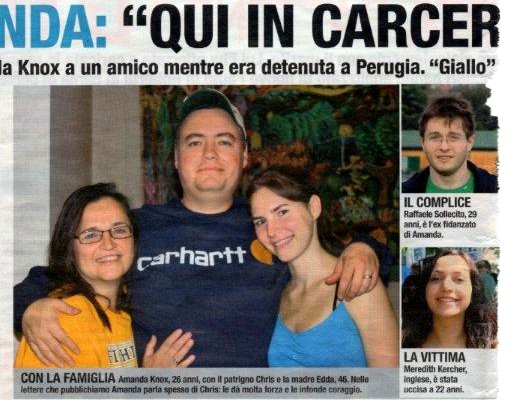
[Header of the Giallo article; the rest off it is at bottom; click for a larger image]
1. The Fake Knox In Her Demonizing Book
Amanda Knox may have felt she was “waiting to be heard” in America but here in Italy we have heard her many times, and we feel we know her pretty well.
Her book and interviews don’t sound like her at all. They sound like nasty legal stunts and nasty PR at work. It is easy to disprove her disparagement of officials and her friends here, and an investigation by the Chief Prosecutor in Bergamo is already under way.
So the big question for us here is not angrily “Who are these appalling police, prosecutor and prison officials, and why did they do these terrible thing?” but sadly “Why was she compelled to invent all this stuff?” and “Why is she so scared to come back?”
2. The Amanda Knox That We In Italy Know
I have translated six of her letters from prison just published in the crime magazine Giallo plus the introduction and the graphologist’s analysis. This is more like the Amanda Knox we know, not the invented one in the book.
1. The Giallo magazine’s Introductory framing of Knox’s letter below
Amanda: “Here In Prison Things Are Okay”
So writes Knox to a friend while she was a prisoner in Perugia. [The true crime magazine] Giallo publishes her letters, and then has them commented on by a graphologist and a psychologist
The letters you see published on these pages are from Amanda Knox, the young American accused, along with her ex boyfriend Raffaele Sollecito, of the murder of the British student Meredith Kercher, that took place in Perugia the 1st of Nov. 2007.
Knox, 26 years old, was acquitted in appeal, but now Cassazione has decided that the appeal must be redone. While waiting for this complicated judicial process to restart, Amanda lives in Seattle, and is traveling around America to launch her new book Waiting to be Heard for which she was paid several million euro by her publisher.
To the American television interviewers, the young American woman has said she is scared of coming back to Italy, because our prisons are terrible places, where she was threatened, molested sexually, and humiliated.
Well, in the letters that Giallo publishes in an exclusive, Amanda writes to a social worker, Maurizio, who helped her, and she seems neither desperate or scared, she has friends and cellmates with which to share many interests, From reading to music, up to manicures. There is a priest, Don Saulo, with which she talks, and confesses, and helps her in her moments of discouragement.
Sure, she suffers from the distance from her family, her loneliness and her imprisonment, but she can see her parents and speak with them frequently, and this notably relieves her suffering.
2. Six letters from Knox to the social worker Maurizio 2008-2010
April 3 2008
Dear Maurizio,
Thank you very much for that letter that for me is very interesting. I was thinking: “Why am I here?”, “why can’t I be with my mother?”, ” Yes the police can think badly about me, and meanwhile I do understand that I have to be in control, not run away from the situation, but why prison? I am 20 years old, never committed a crime, it is senseless. How can they say that I have to stay in prison like the people that can be a danger to others? Above all when they don’t know the truth?
It really is a torture and now I understand the motivation. I understand the motivation, but I do not agree. “Sweet” or not it is a “TORTURE”. I am being tortured and it is not right…...
Sorry. As I said I do suffer a lot in prison. Generally I am scared, alone, with no hope, sad, and tired, even if I am innocent.
Thank you for the article. It is interesting to know how people that do not undergo this torture as I and hundreds others think. To tell you the truth, I can’t understand how some judges can sleep at night, when they very well know that it can be a grave mistake. ah… mamma mia….
Come on! It is O.K. here. I am studying a lot and have started reading Italian Poetry.
Another thing that I like a lot is the song “A te” by Jovanotti. “perché tu sei…semplicemente sei….sostanza dei giorni miei…sostanza dei giorni miei…. (lyric of the song n.d.r.). Have you heard it? According to me it is a live song. It is true. Simple and strong. I like it a lot.
How are you? Do you like the change of weather? I spend more time outside reading a book and singing (I am still alone when I go outside). I am sun tanning but I’m still white white!
Hope you are OK. Love, Amanda
P.S. Let it be! Here comes the sun! I know that I am not alone, even when I am alone
April 28 2008
Dear Maurizo,
Thanks again for your thoughts and your gifts.
I really like the T-shirts and the book of art. Beautiful! Mamma mia the talent of the artists always surprises me! Thanks. But you know, you do not have to buy me anything. I am happy just to hear from you.
Really, [Priest] Don Saulo speaks to me so much about God’s gifts, especially about the strength to overcome the difficult moments, of which there are so many. He bought me a book on philosophy entitled “Umanesimo Integrale” and we speak often of my thoughts and my questions. He is a true friend and a very good man.
It’s true, I must start to read a bit of classic Italian texts. Maybe there are some books in the library for me….......Who can explain to me about “Divina Commedia”? I know it exists and that it is famous, but more than that I am ignorant, unfortunately.
Now my father is here with me, but he has to return to the United States, next week. In his place the husband of my mother, will come. I am happy, because from him I receive a lot of strength. He is like that.
Today I go to the gym course (in a bit) and I have a home telephone call. My first telephone call was last week and I was so excited. The voices of the people I love are really a gift. I trembled a bit after those so little ten minutes.
Now, I must go to the course to sweat a bit. 😊 I hope you are very well. Thanks again for your words.You are very kind.
A hug, Amanda 😊
P.S. Let it be! Here comes the sun! I know I am not alone, even when I’m alone.
November 26 2009
Caro Maurizio,
Ciao, my friend. How are you? It’s from forever that I write you. I imagine that you must have basketball in your head, since it is the season’s sport. I send best wishes to your nephews, who play it. I am terrible at basket. I have very small hands, therefore I can’t control the ball.
I would like to thank you for meeting with my family. Chris told me nice things about your encounter, he was impressed by your generosity. I know that it is always nice and unique, every time that somebody comes toward you and they like you, just like that. Therefore, thank you, for having welcomed him, me and my dear ones.
Nearly, nearly there. O mamma mia, one has to remain strong in these days. I am always hoping so much, even if, in my stomach I feel sick, anxious. More than anything, the closer it gets, the more I have to reinforce my patience against the fatigue and frustration. But I will make it.
A lot of my family will come tomorrow to be in court. There will be my father, my mother, my stepmother and my aunt. My three sisters will be here on Dec. 2. I hope so much to be able to go home with them, finally, this time. I see it in “my third eye” the vision of being on the plane between my mother and my sister. Maybe, I am thinking to much about it.
Anyway, I hope you are well. I must go to sleep early tonight, to be ready for tomorrow.
Thank you for your continued support.
Your friend, Amanda 😊
Here comes the sun! Let it be! I know that I am not alone even when I am alone,
Happy Thanksgiving!
April 20 2010
MAURIZIO
Hi! How are you? I’m happy that I made you happy with the full translation. For me it was a satisfying job, so I thank you too for the chance that you gave me. I don’t think it will be a bad thing put up my name as a translator. OK it is fine for me and yes if you like it, you can even put my second name Marie,
Thank you very much for the towels, to be truthful I really needed them. They are beautiful. I gave one of my pillow cases to the other inmate so we have twin pillows. She thanks you too and sends her best wishes.
Seems like that the weather is finally changing. With great pleasure I was able to wear a skirt in these days. Now people are out and we play volleyball together under the sun. I made friends with a new 19 years old girl: she is an athlete too. Every day we walk or play with the ball together,
Next Friday my mother, father and stepfather will be here for a visit. Mi mother and father are here for a short time to be interviewed on TV at “Quarto Grado” and then will come here. Can’t wait to see them, I miss them with all my heart.
Well, hope that you are fine. Thank you again for everything and salute you with all my affection
Hi your friend, Amanda
I know that I am not alone even when I am alone
August, 30 2010
Dearest Maurizio
Hi dear, how are you? Do you know that yesterday I was taking with D…. about you, only because you are a very special person in this world, for all that you do for others. She told me that you got married. Congratulations! Now I have to tell to my grandmother and break her heart! 😊 Just joking!
I am well enough here. I thank you again for the shorts and shirt that you send me. They were perfect as always. Thanks and I hope that you didn’t lighten your wallet too much. I am kind of disappointed that you spend your money on me, you are too generous. I am always the same here.
Just finished reading a book by Umberto Eco book that I liked a lot. In Italian should be ” L’isola del giorno prima”, I read it in English “The island of the day before”; maybe the “island of yesterday”? Anyway, I was favorably moved by Eco’s organization in this novel in order to communicate so many ideas on science, philosophy, ethic, imagination, literature. It was a book very rich on thoughts, and colpi di scena during it’s path.
I like Umberto Eco because he meticulously builds the story that he wants to tell. Of all he writes, nothing is taken for granted and this is remarkable, he has a fantastic mind to dig deep while following a long track. I saw a Sean Connery movie based on a book of his “Il nome della Rosa?” It was fantastic. Always meticulously built, deep and fascinating.
Seems like that the newspapers know before us when the appeal proceeding will take place. We still have not been officially notified, but my lawyers told me that it should start Nov. 24th; that in the USA is Thanksgiving Day. Hope that it is a good omen even if there is a lot in my life for which I should be grateful: to be alive, having the family that I have etc…
[Undated letter]
Dearest Maurizio,
I am happy to hear from you again. I use now the paper you sent me to answer you. Sorry to make you wait. My mother has returned to the United States nearly a week ago, and my father returns to Italy tomorrow, to see me Tuesday.
I am happy to remain in Perugia. I do not want to restart everything in another place. Also I? (blurred) have heard that the prisons in Rome are harsher than here. Who knows?
I only know that at least I know some of the prison officers fairly well, after all this time. I would be sorry to leave Don Saulo. I feel fine in my new cell. I changed it so I could be with a girl my own age. We joke, cook, we do manicures. Further, she does a manicure for me, because I do not know how to do one. We listen to music a lot because she has a radio.
Thank you for all you do for me. The paper, your words of confidence, your prayers. To Don Saulo I will send your greetings. Do you write often to him too? I hope all is very well with you. I send you a big hug. Ciao! Thank you!
Amanda Knox 😊
Let it be, Let it be! Here comes the sun! (drawing of a sun)
3. Comments by educational psychologist and graphologist Evi Crotti
Looking at the Amanda Knox letters it is evident right away how organized and precise she is: she has a perfect handwriting, elegant and without smudges. We try to interpret it with the help of the graphologist and educational psychologist Evi Crotti.
She explains: Her perfect, organized handwriting, without margins and few spaces indicates that we have before us a girl that is decisive, strong, who wants to dominate, and knows she can succeed in life. She puts herself In the center and leaves no place for others. Amanda displays a way of writing that is typically northamerican, in small print, called script.
The handwriting, elegant, big and curved, reveals an extroverted personality, and with a notable sense of taste. Her language is fluid and polished, and the accuracy with which she writes, tells us that this young girl has a need to maximize and nurse her image, to the point of becoming narcissistic: after her signature she draws herself with a smiling face.
Amanda leaves no space between the lines: this signifies an element of interior loneliness, which she attempts to compensate at any cost with approaches of verbal intrusiveness. This tells us that that her strong narcissistic behavior can escape control and lead her to present unstable behaviors. The fact instead that her handwriting is always in horizontal lines, without blurs, gives testimony to her practical intelligence and her strong tenaciousness, that allow her to reach her goals.
Also, the handwriting is rigid and this signifies that she knows how to use words with care and determination. Evi Crotti underlines that the handwriting is static: It is a sign of a behavior that is very seductive. Attention, the need to be attractive at all costs can make her lose sight of the objectivity of judgment , taking her to a subjective vision of circumstance reality.
Conclusion: Amanda seems to be in a continuous search of approval and acceptance from those who live around her. Her egocentricity, maybe pushed unto the point of a bogus personality, demonstrates that this girl possess a highly emotional immaturity that doesn’t allows her to love in an unselfish way. The handwriting slightly slanted to the left indicates a contradiction between the need to be liked and the reactive refusal toward a feminine figure: for her, probably every woman represents a rival.
Tuesday, May 21, 2013
The Amanda Knox Book: On Top Of Everything Else It Seems The Book Is Financially A Huge Flop
Posted by Peter Quennell

Bizarrely, Amanda Knox might have run into a bit of luck.
She will be able to point at upcoming court events to the fact that this seriously nasty and thoroughly dishonest blood-money book fooled a lot lot less book-buyers than had been hoped.
In The Week Andrea Vogt quotes confirmed publishing industry figures to show sales so far are a mere FIVE PERCENT of what was hoped. The book is not selling anywhere in Europe now.
Even in the US, Publisher’s Weekly said the memoir “underwhelmed” and was “slow out of the gate”. As of last Friday, it had lost 30 per cent of its sales from its debut week, falling back to No. 5 on the non-fiction hardcover bestseller list despite Knox conducting dozens of interviews in the hope of boosting sales.
It was hard not to conclude that the more the interviews, the more the sales seemed to drop. They sure sent a lot of new readers over here. Knox has yet to do even one interview that is a clear win, and a lot of offputting jubilant ego has been creeping in.
The publishers would seem to be down $1 million to $2 million or more, and Knox and her people have probably received in the publishers’ advance all the royalties they are going to see.
Andrea Vogt is the first and still the only English-language reporter to describe the most serious (Bergamo) complaint. Did nobody think to take into account Knox’s new legal liabilities and possible large fines and defamation awards?
Bob Barnett has sounded a bit besotted by Knox. A siren call that many have come to regret. We could accept that she needs help, but failing her in due diligence is the worst possible kind.
Saturday, May 18, 2013
Seeds Of Betrayal: In Interview Knox Reveals To Italy Her Considerable Irritation With Sollecito
Posted by Our Main Posters
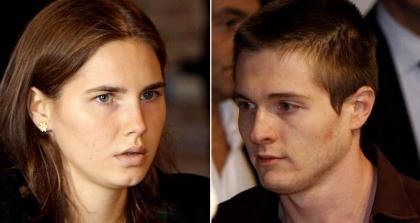
For some odd reason, Amanda Knox has decided she is not loved enough in Italy.
Could it be because she is widely seen to have lied her way through trial, came across as loud, self-absorbed and callous in her 2009 testimony and court interventions, served three years for framing her her kindly employer, was reported as being just as grubby and tin-eared and sharp-elbowed as ever in prison, slimed Italy though her cohorts in much of the English-language media after her 2011 release, and has now written an illegal blood-money book which once again slams a benign Italy?
In particular it slams the justice system, one of the most popular and trusted institutions in Italy, and its officers of the court, with more proven lies and contradictions with past testimony being unearthed daily.
Apparently in Knox’s mind it was all really Guede’s and Sollecito’s faults.
It was they who tarnished her image. Here in an interview in the current Oggi (which appears just as in contempt of court as last week’s Oggi article now the subject of a criminal investigation) she sets Italians straight.
Translation here was by our main poster Miriam, who is herself in Italy - and in disgust.
AMANDA KNOX: ITALIANS; WHY DON’T YOU BELIEVE ME?
Amanda Knox answers the phone with a bright voice and no signs of fatigue. Strange. She is a veteran of a promotional tour that would have knocked-out a bison. Her book “Waiting to be heard” is selling like mad [it is?] but it will not be published in Italy: our publishers have a - sound - suspect that it would set off a number of complaints for defamation, and they have decided to not publish it.
“I’m sorry” she says. “The Italians believe that I am full of hate for them, but if they had the opportunity to read my book they would discover that there is not a trace of anger in it. It hurts that so many believe that I am guilty, that I wrote the book out of arrogance, for money. It is not true.” Says Knox venting her frustration.
Following the Cassazione’s decision on March 26 to redo the appeal process - which had absolved Amanda and Rafaele Sollecito - the British publishers also pulled back.
“They asked me if I wanted to postpone the book launch. But it is my turn to talk now, and I do not intend to alter my story just because somebody threatens to sue me.” Amanda is nothing if not pugnacious. “Compared to how I was before I came to Perugia, I am quieter, even timid. My family is disappointed: the sunny happy Amanda no longer exists.”
Your personality - the way you reacted to Meredith’s death - caused you many problems at the time.
“People involved in a tragedy can react in many different ways, and your behavior can be manipulated to reinforce the idea that you are the one who is guilty.”
What are you referring to?
“To the infamous images taken outside of the small villa on the day Meredith’s lifeless body was found. Those images were cut and obsessively repeated, so as to only show Raffaele and me kissing.” The message was clear: “their friend is dead and all those two think about is kissing.”
What were you feeling at that moment?
“I hadn’t understood what had happened; I had not accepted the fact that Meredith had died in such a terrible way. I felt lost and sad. I was desperately trying to understand. Raffaele kissed me to console me: since I did not speak Italian yet, there was a linguistic barrier between us that prevented us from giving each other verbal support. And then, to re-enforce the strangeness of my behavior, there was the contrast of the cries of my roommate Filomena Romanelli. She is Italian, she had understood. She had seen Meredith’s room, the body, the blood. Not me: I was in total confusion.”
In the book, Honor Bound, Sollecito writes that your behavior that day was “embarassing”
“I don’t think he was embarrassed . I can understand that he would find me “clingy”. I depended on him completely; I was absolutely clingy. However, he knew how they were looking at us, while I hadn’t considered at all how people might have judged us. I was simply reacting in my lost and disoriented way.”
One of the PMs believes that Guede didn’t act alone. Could he have had an accomplice?
“I can only base my opinion on what the prosecution brought to court.”
And?
“They found another person’s DNA in Meredith’s room, a person that has never been identified. A smaller amount of DNA than Rudy’s. There is Guede’s bloody handprint on the wall, his footprint, his DNA on Meredith’s body. This evidence leads me to believe he acted alone.”
John Kercher, Meredith’s dad, maintains that his daughter had studied karate as a child, and that she would have fought to survive. He believes one man would not have been able to subdue her.
“Of course Meredith fought, but what could she have done against an armed man? Rudy is athletic, and is not small. Mez was minute, she maybe weighed 54 kgs, what good could have Karate done her? Even a man if faced against the likes of Guede, armed with a knife, would not have stood a chance.”
How do you explain Rudy’s calm countenance during the trial? Before being arrested he had told a friend - Giacomo Benedetti - on Skye that you and Raffaele had nothing to do with the murder. After being arrested he started accusing you.
“Yes, it is a strange coincidence. I do not know if he changed his story based on his own ideas or those of his lawyers or the prosecution. I only know that after his story changed, the PM began calling him “poor Rudy” to demonstrate how fragile he was, and consequently how easily manipulated by me.”
When and why did you break up with Raffaele?
“When he “broke” my alibi (during a police questioning, Raffaele claimed to not remember if Amanda had left the house the night of the murder, editor’s note.) It was a shock for me.”
“A shock that combined with the fact that we did not communicate for a long time while in prison erased my feelings for him. In prison I had to focus on survival and put love aside.”
Back in Seattle, James Terrano became your boyfriend.
“We had been together in university. While I was in prison, we wrote a lot, but just as friends. When I came back home, we began looking at each other differently.”
Do you live with James?
“No. At first, I lived with a friend (Madison Paxton, who had moved to Perugia to be closer to her, editor’s note) now I live alone. James is often at my place, we’re very close, but we don’t live together.”
Did you see a psychiatrist to get over your prison experience?
“Only once, I started crying and never went back. I talk with my friends and with my family; I don’t need an “external consultant.” Writing the book was extremely helpful; I freed myself of all my anger and my wounds.”
What will you do now?
“I took a break from university to write my book; I’m going to go back and would like to graduate next year. I would also like to write other books, if I can afford do. My financial future is very uncertain.”
But everyone says the advance on the book was fantastic.
“I’ll just say that I still have not been able to meet my first goal: repay my family for all expenses incurred in defending and staying close to me.” (One and a half million dollars, editor’s note)
People have also mentioned a movie.
..
“I’ve heard the same. I don’t know how being on the set would be; perhaps not as terrible as I imagine.”Is there anything you regret?
“Yes. I regret not having immediately contacted Meredith’s family, of not having expressed my feelings and sorrow to them. At the beginning, perhaps, it would have been possible. It hurts to know that John Kercher believes I’m guilty, and that this belief is based on faulty information. I had hoped that once absolved, the Kerchers would have believed me. But that didn’t happen.
Maybe the new trial will draw out the truth
“That is up to Rudy, but I doubt he will do it.”
In May 2014, Rudy could receive the first permit allowing him to enjoy a few days out of prison.
“That’s crazy. It’s simply insane for them to let a guilty man loose because they refuse to admit they were wrong about me.”
Yes Rudy! What about that? Why did Knox’s own lawyers and the Supreme Court accept that overwhelming evidence proved three people did it?
And why did you say she did it? And why do her own parents believe she did it? How did you accomplish those tricks? Amanda says: speak up.
